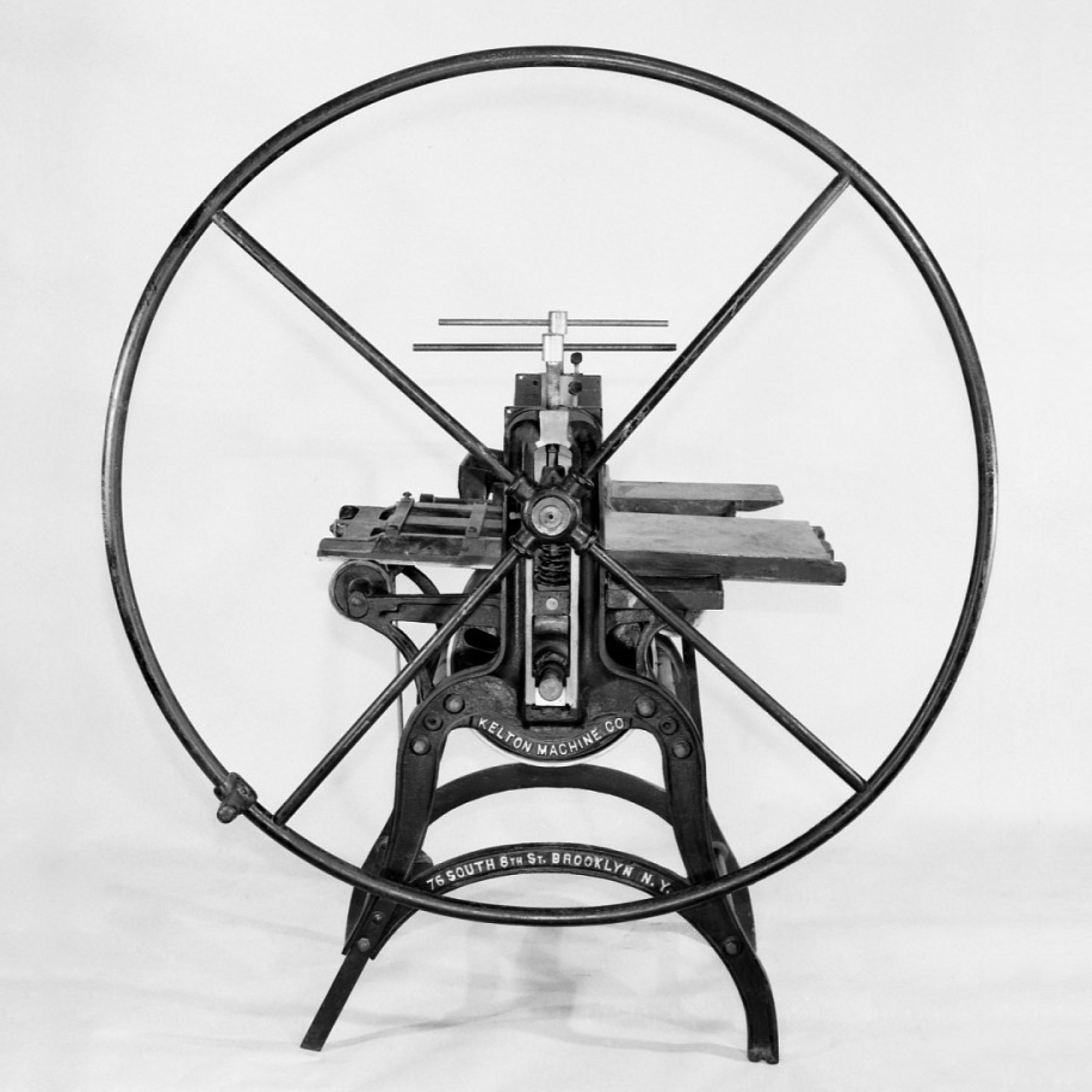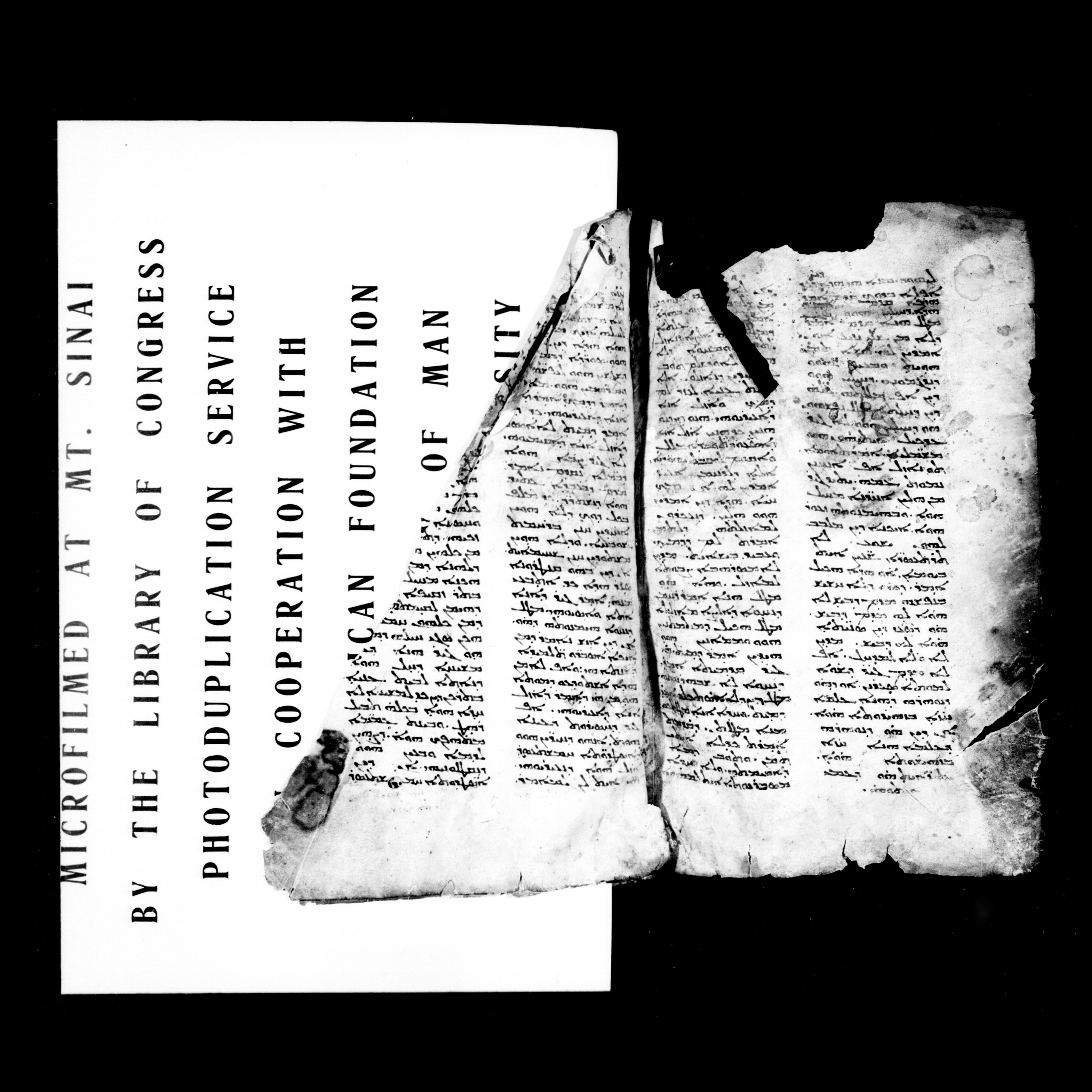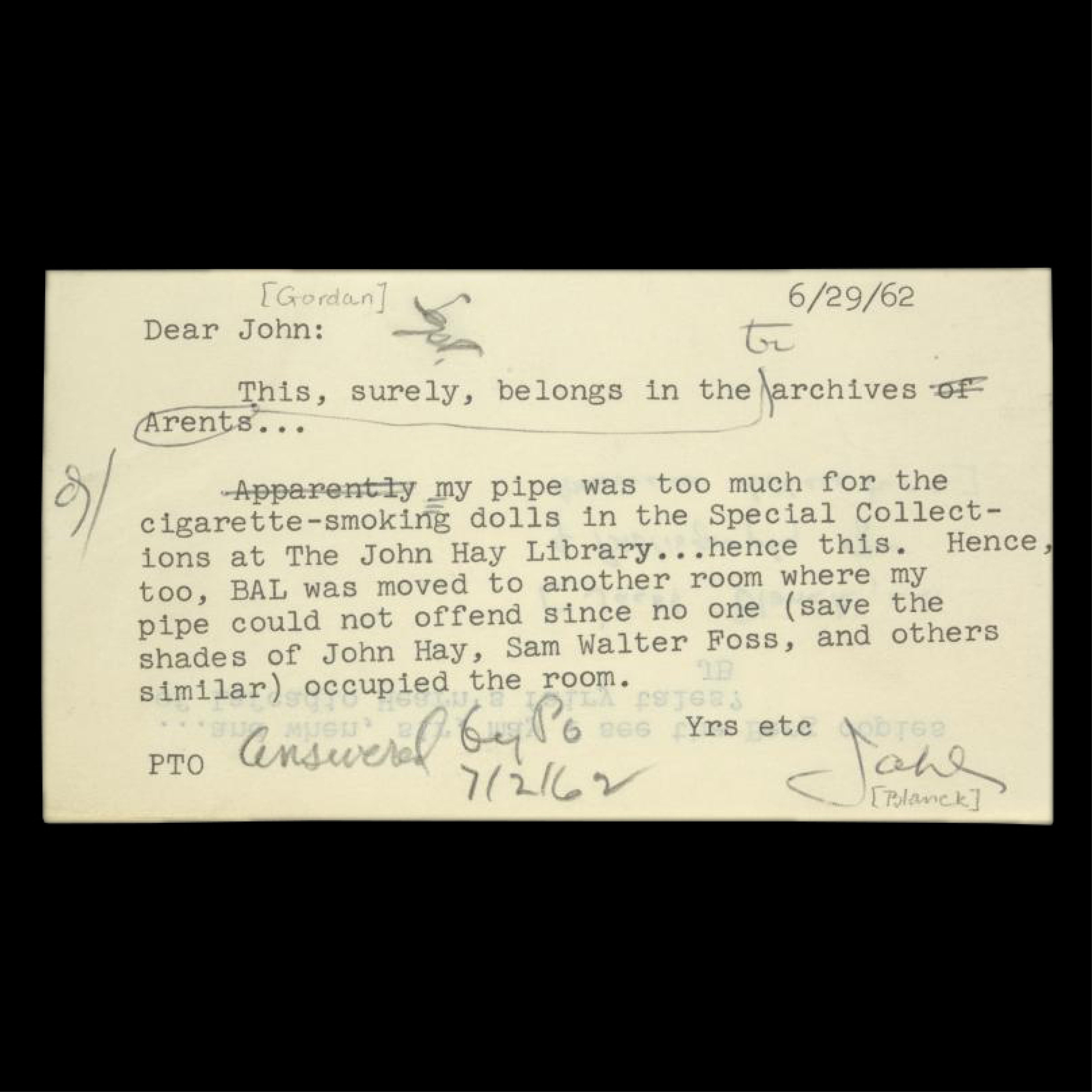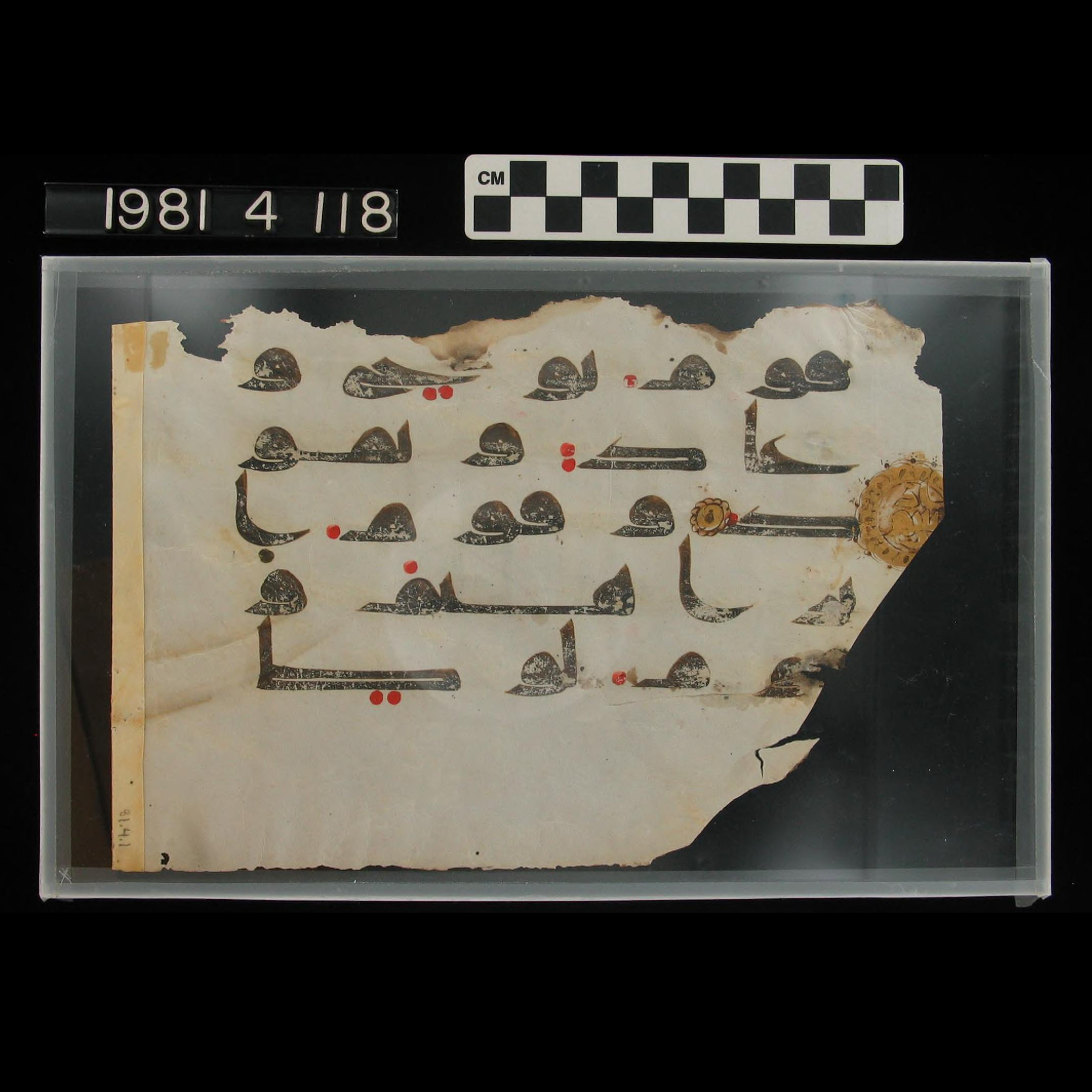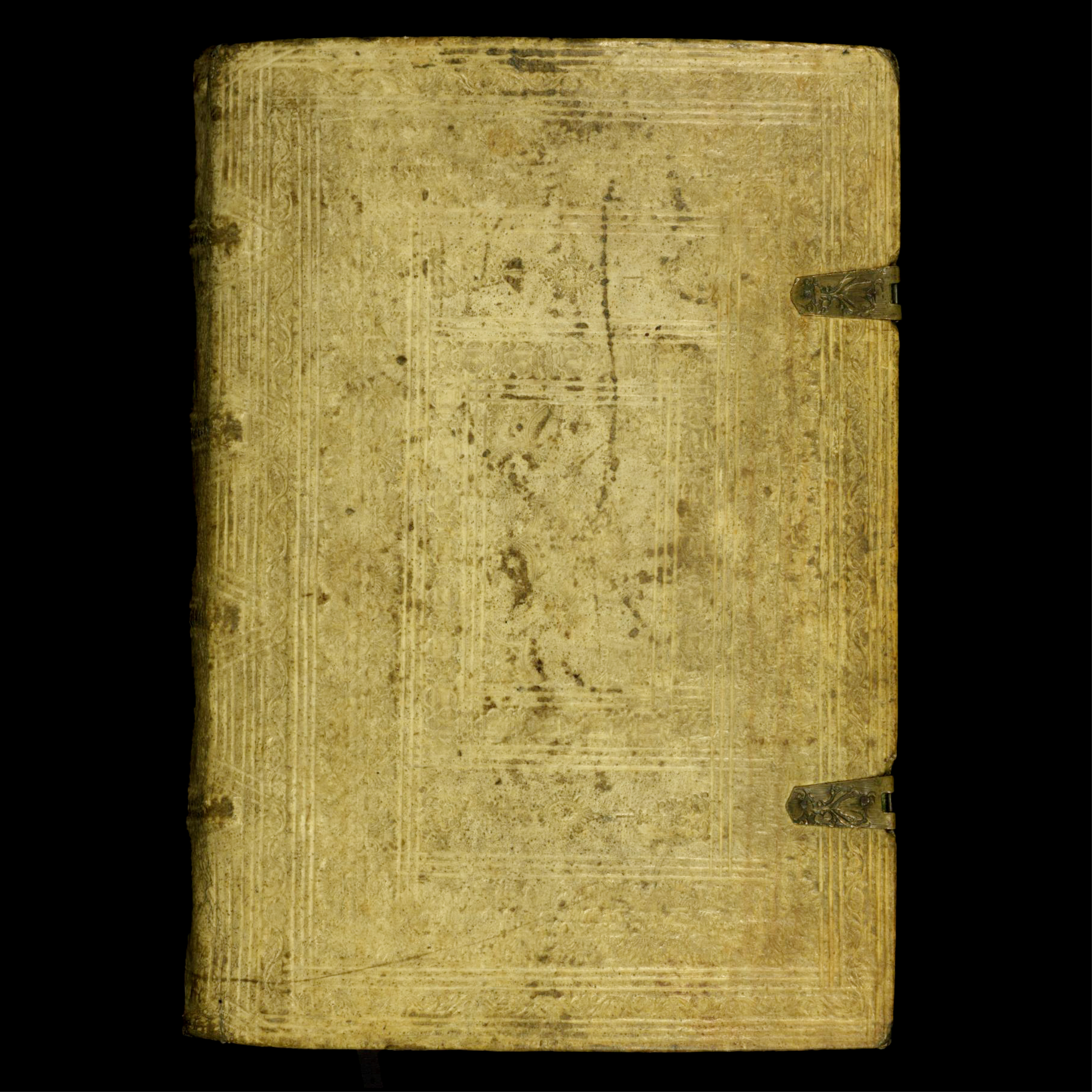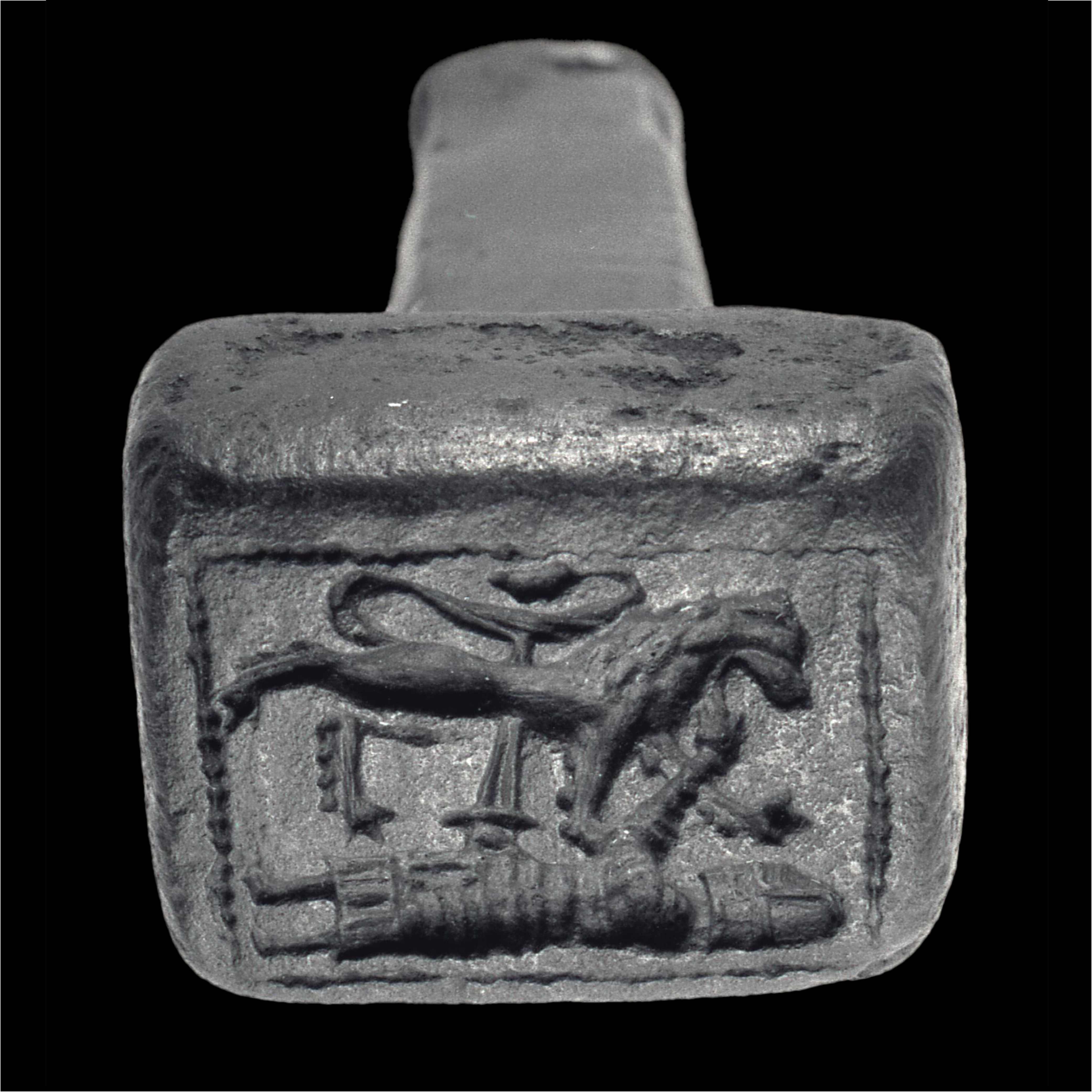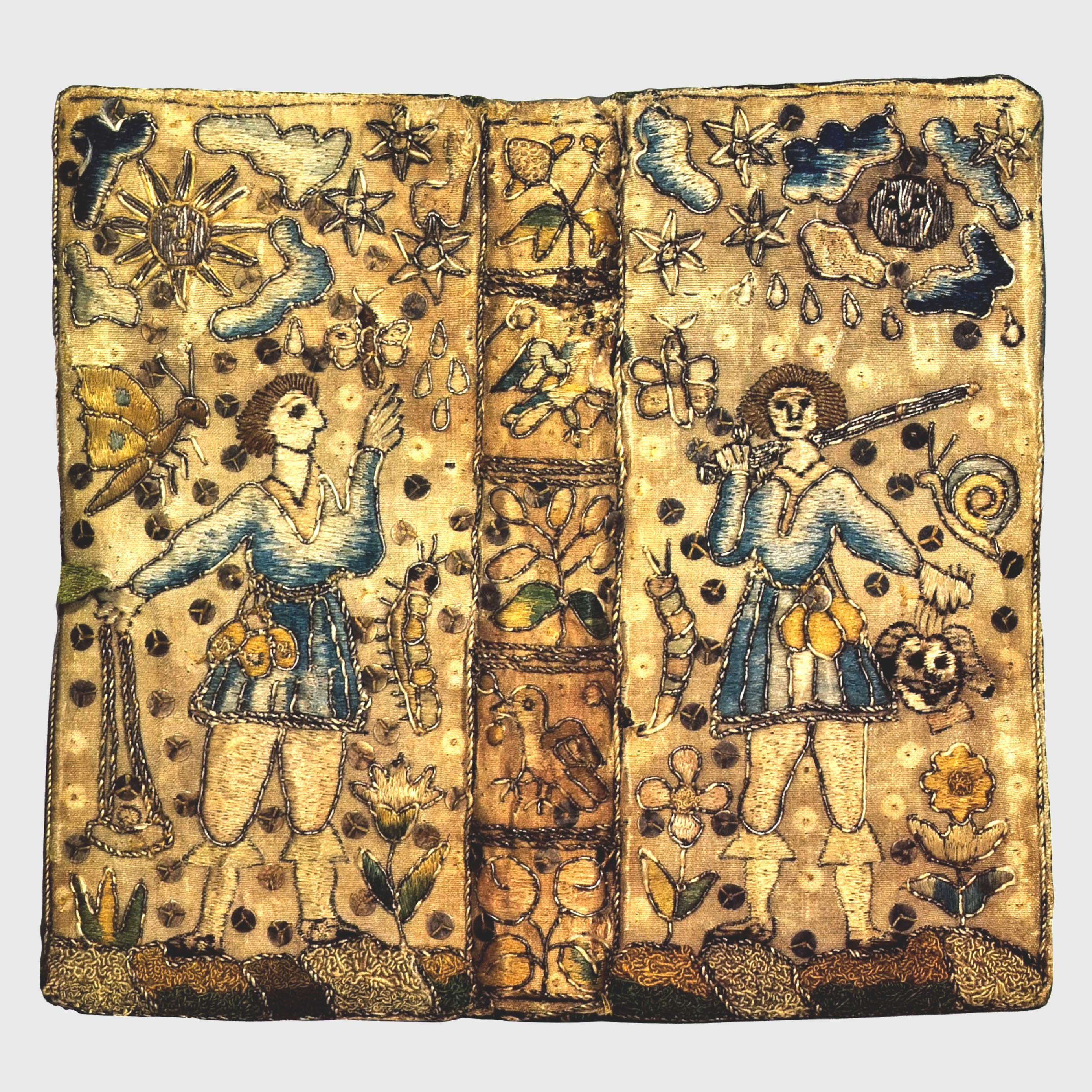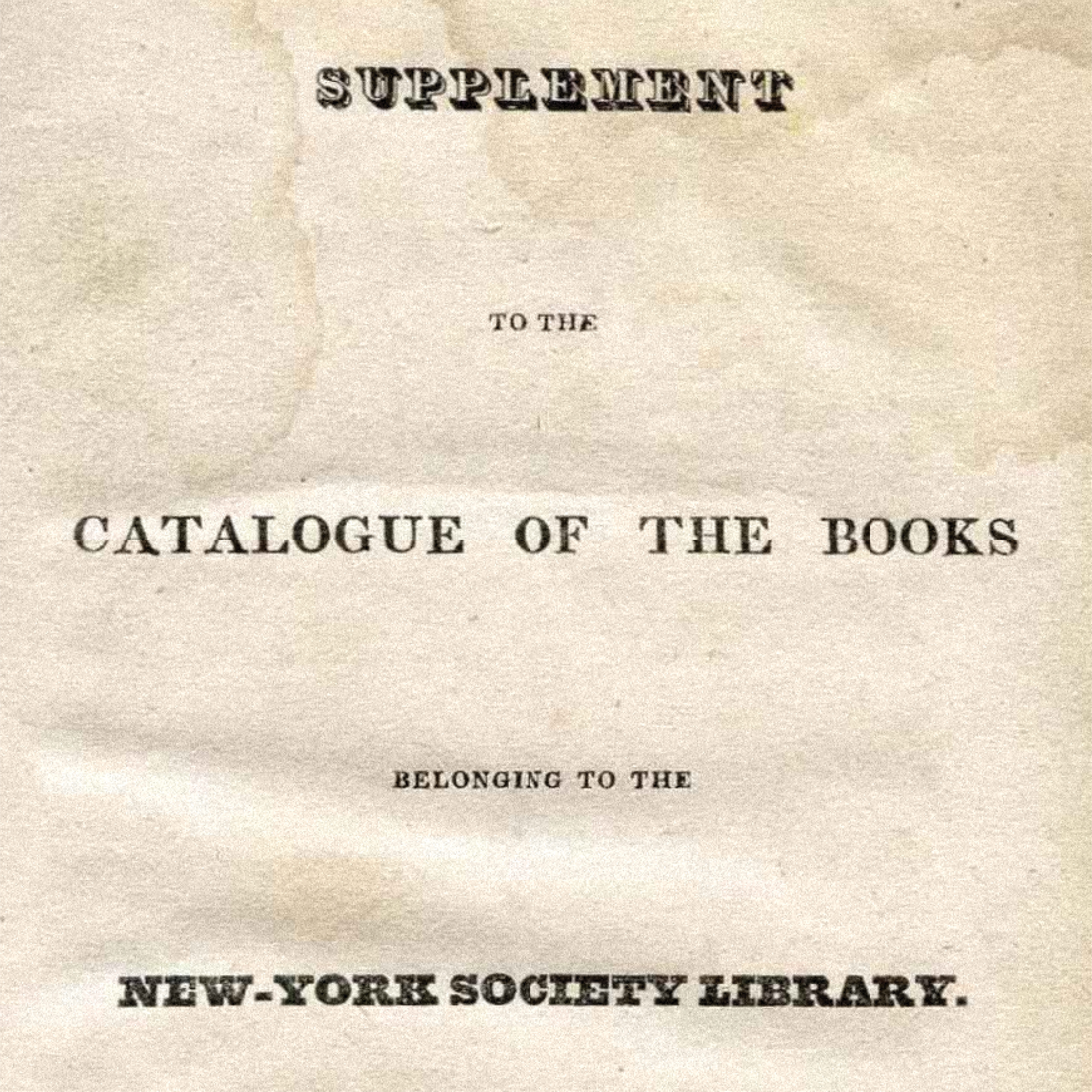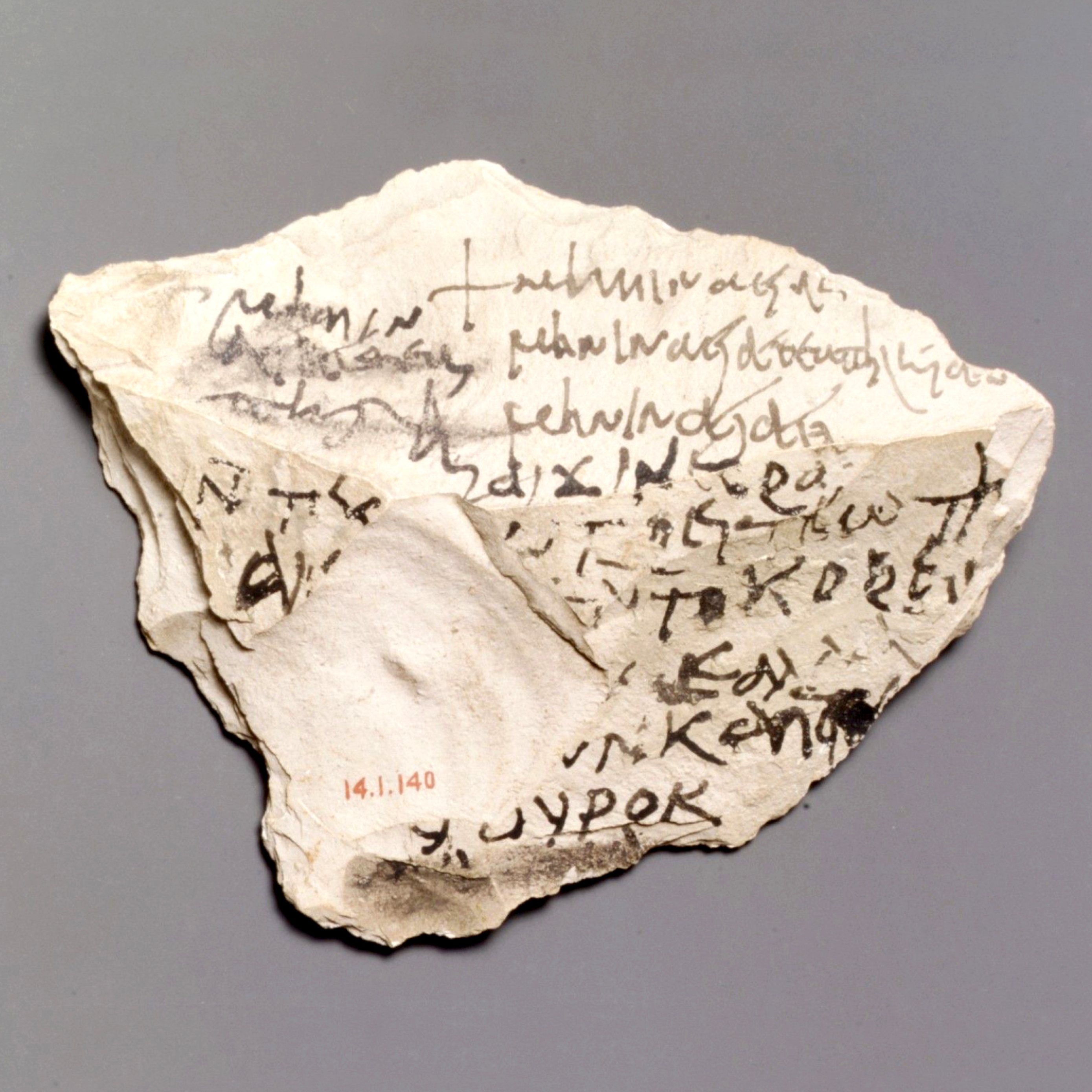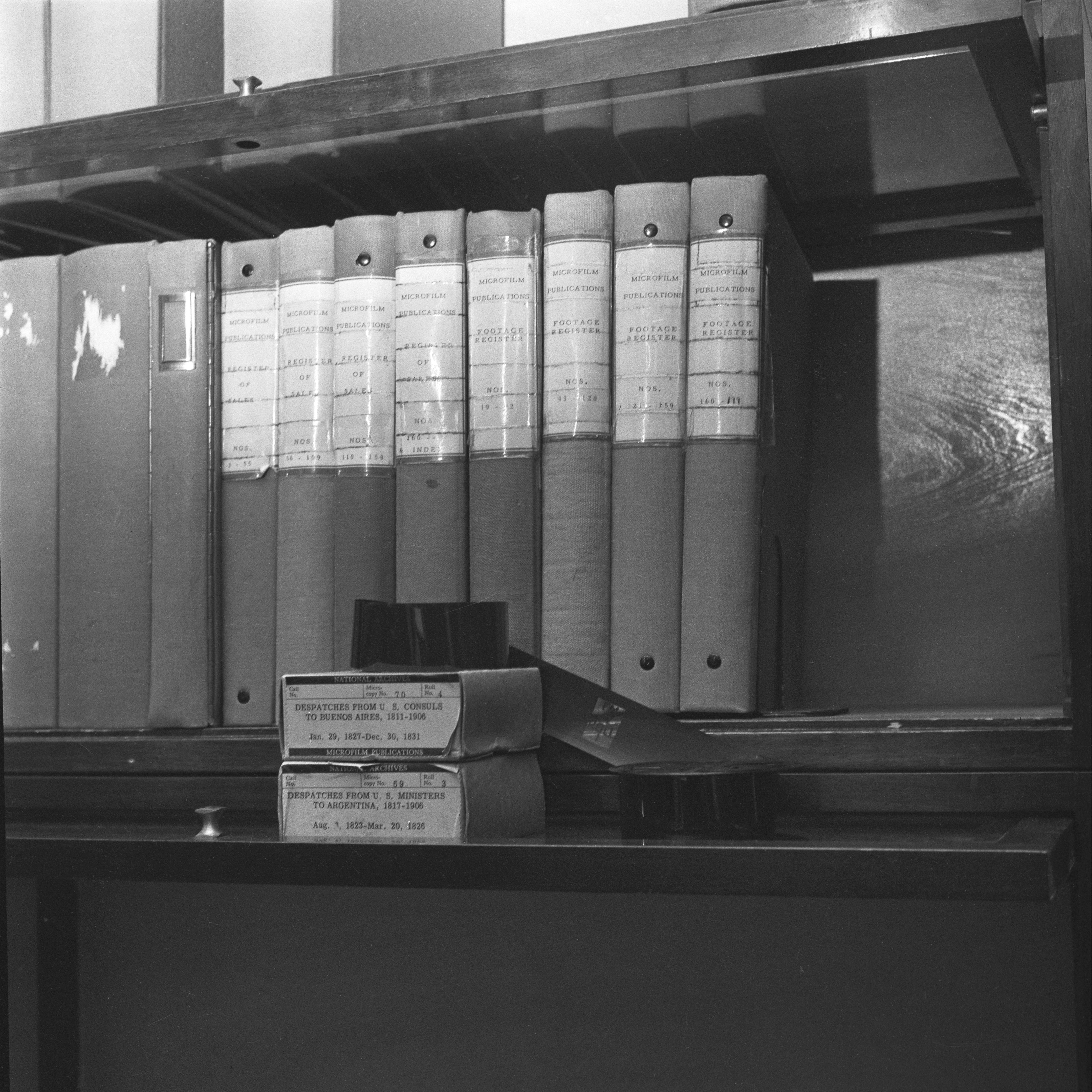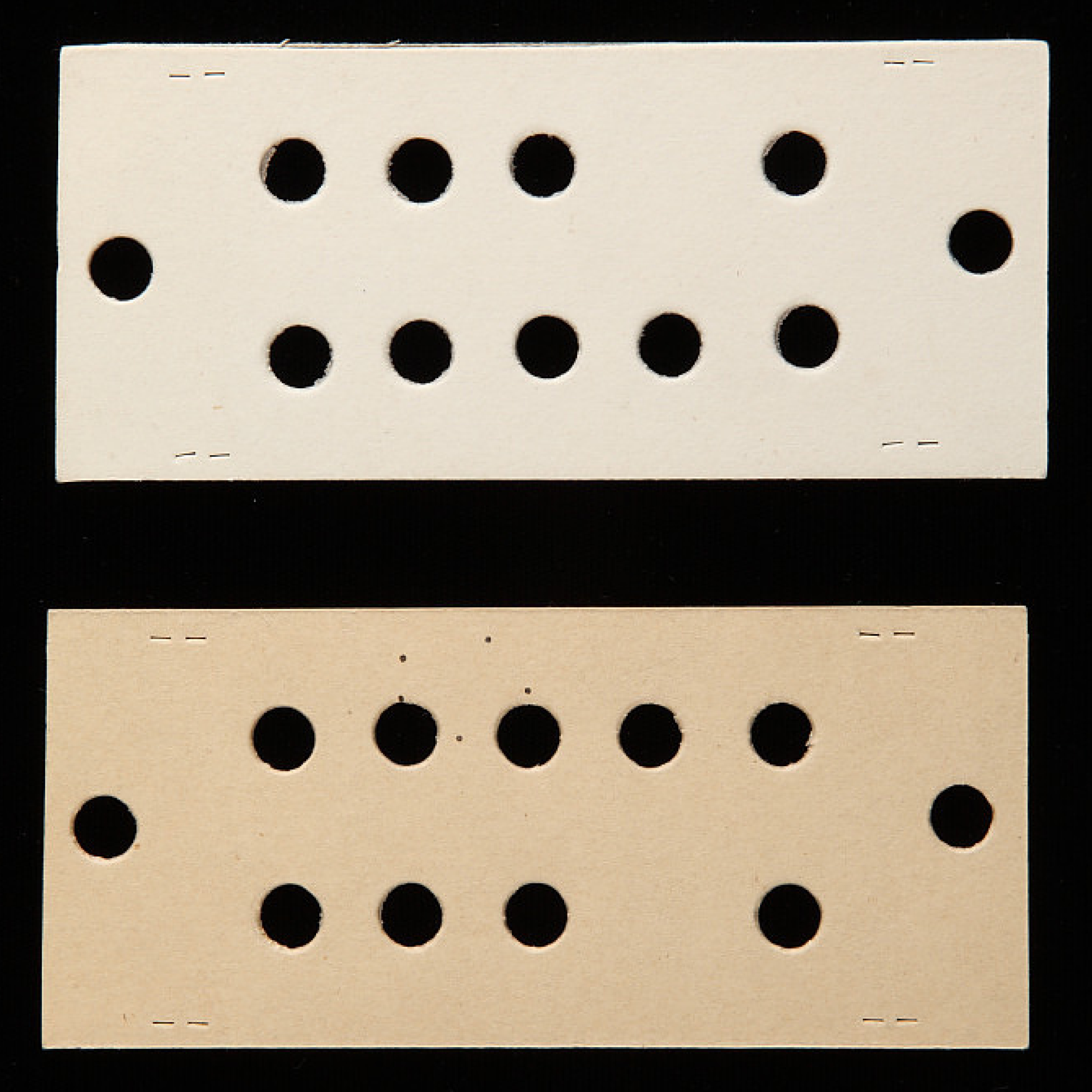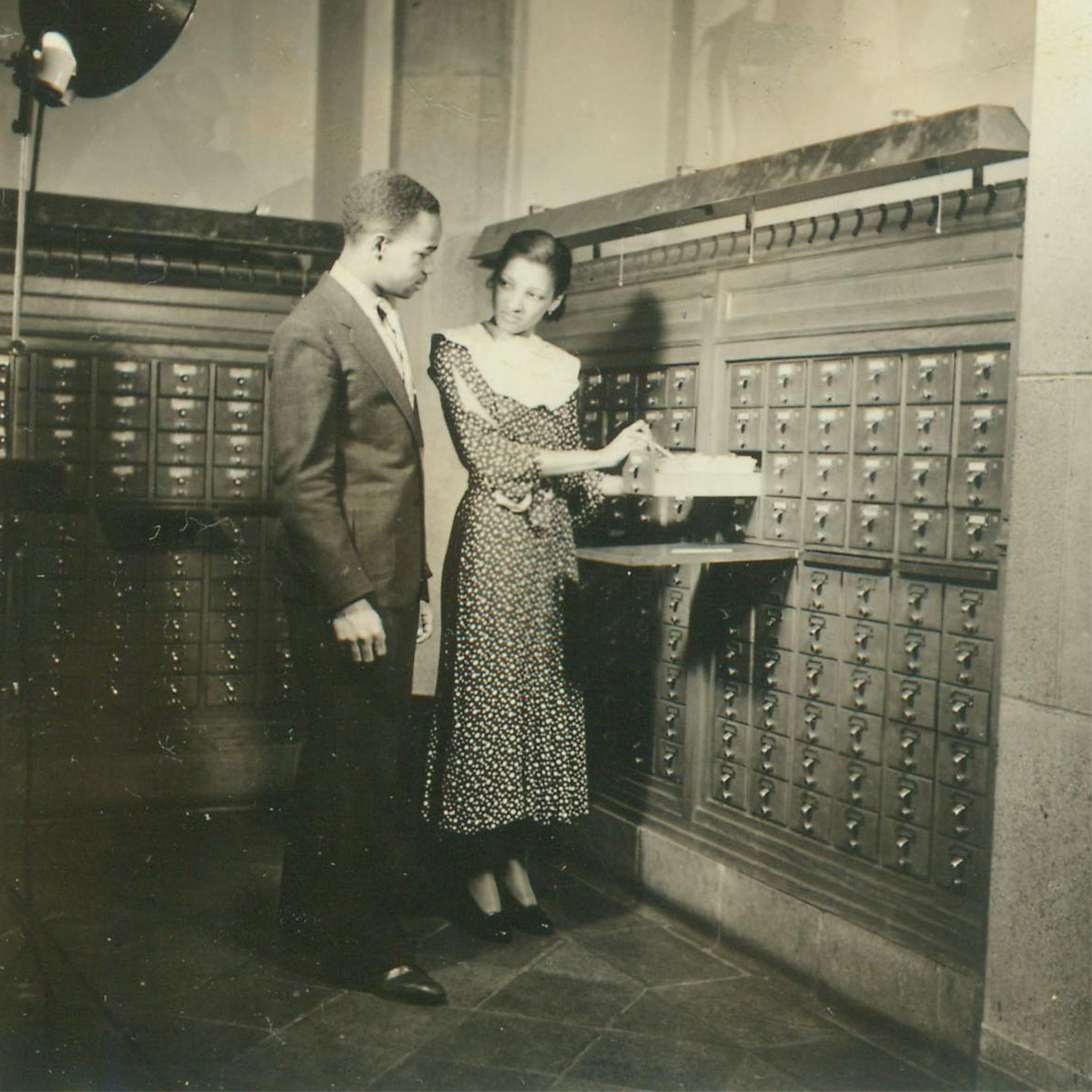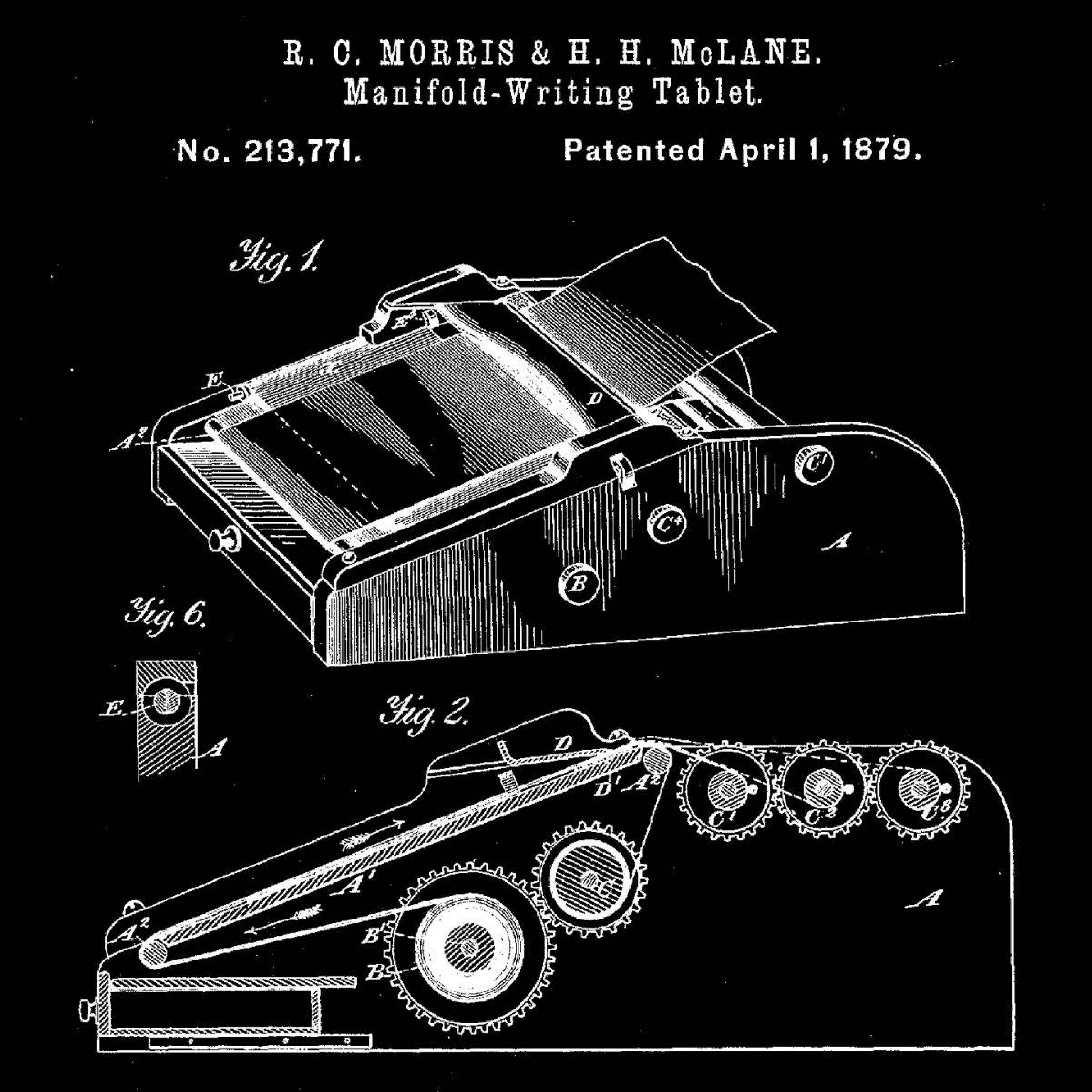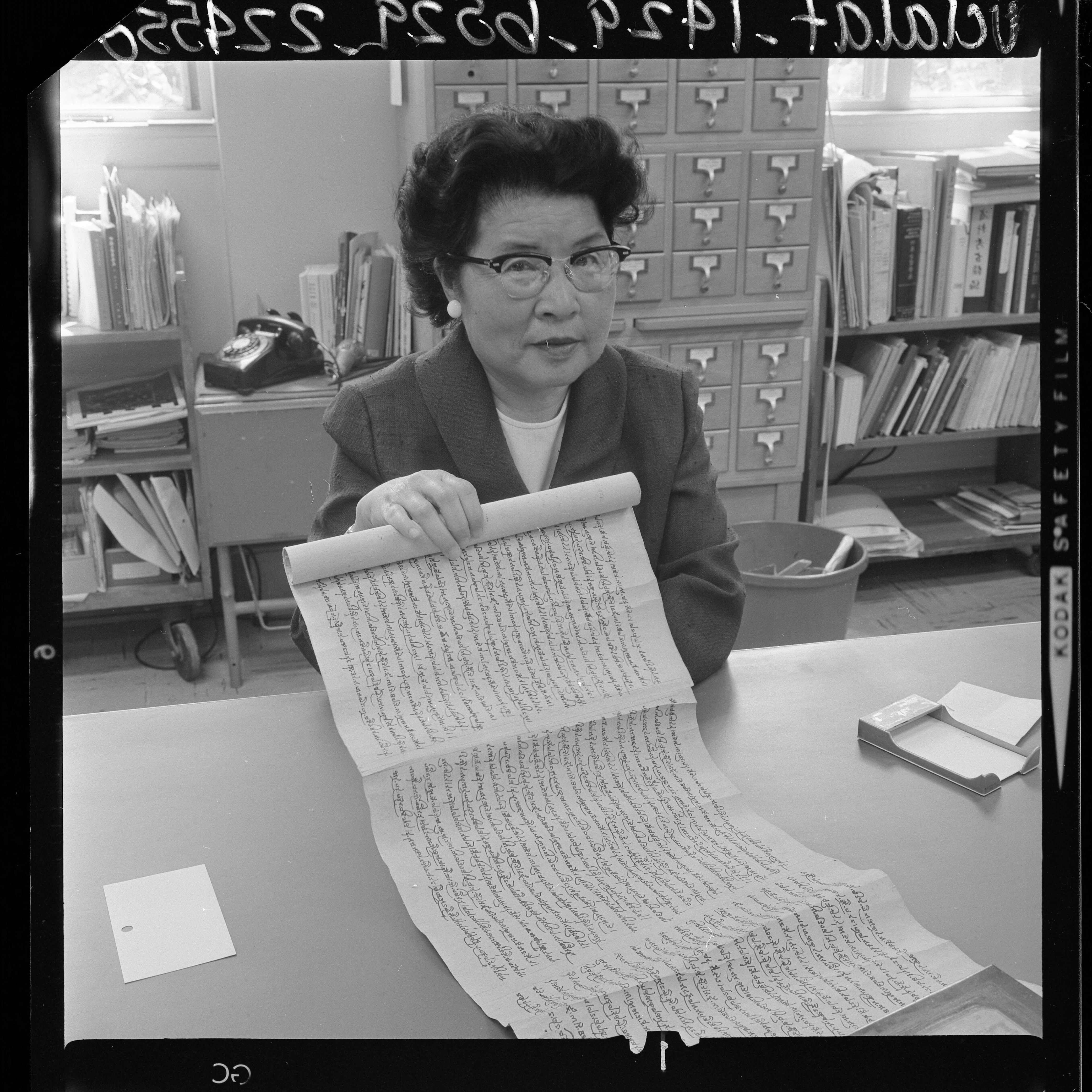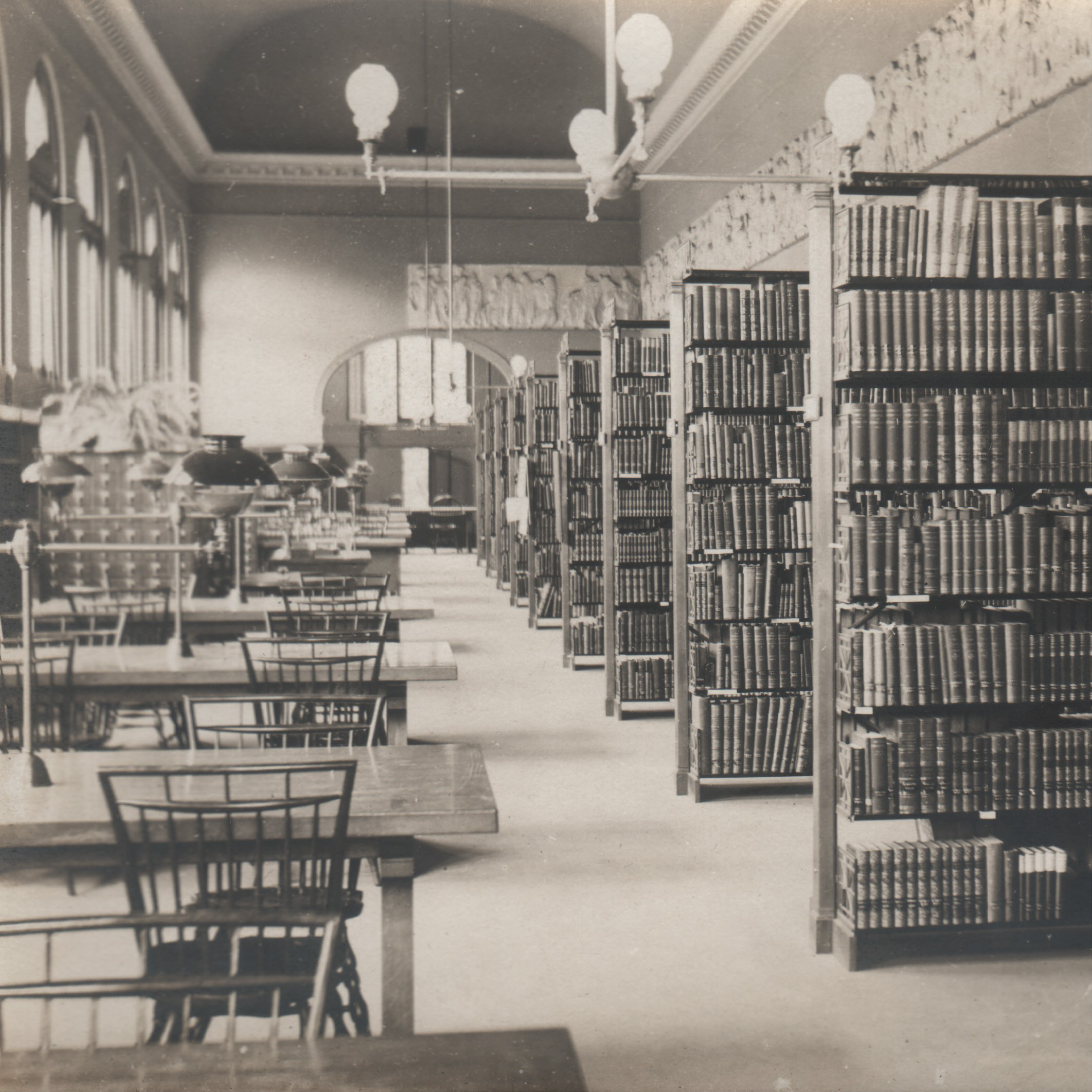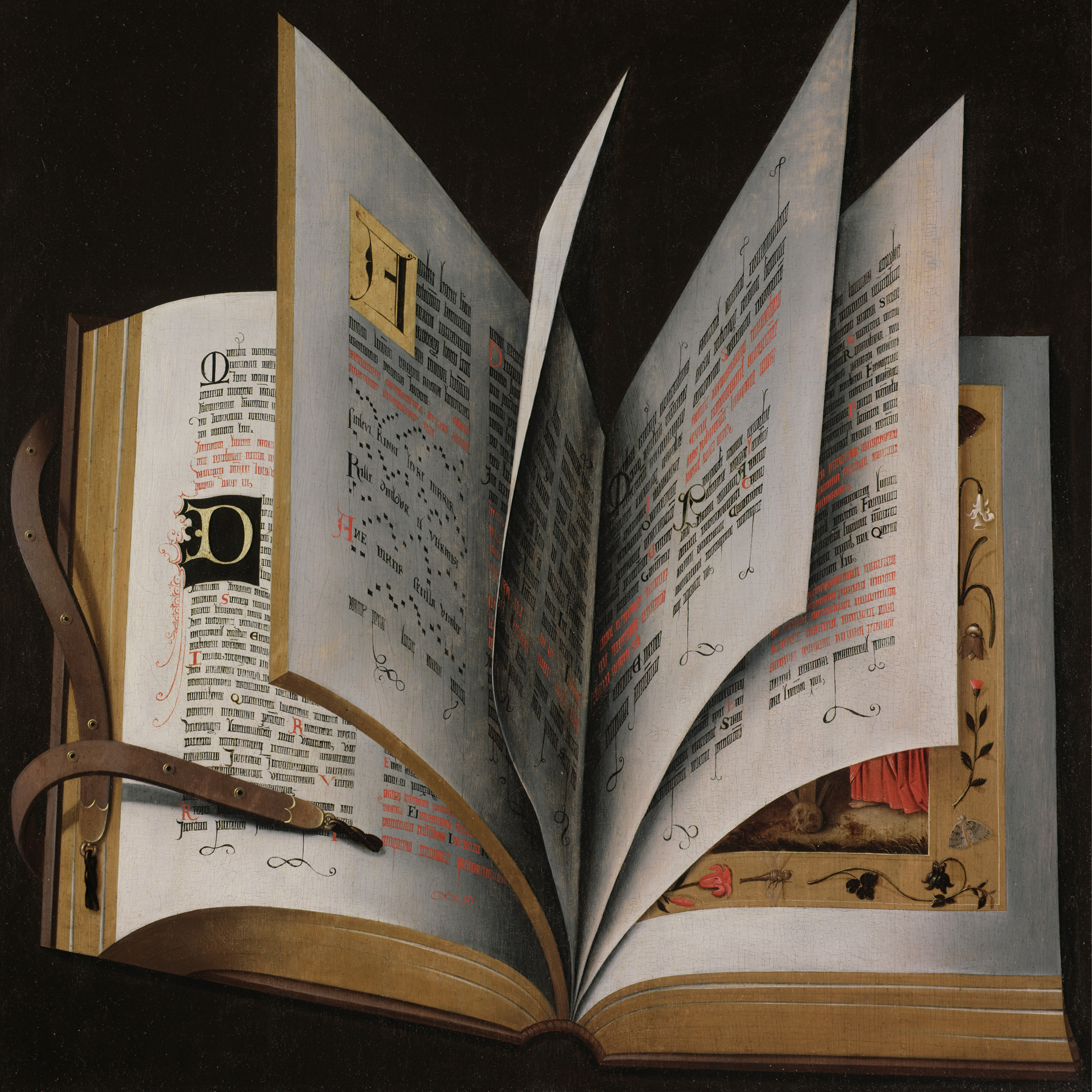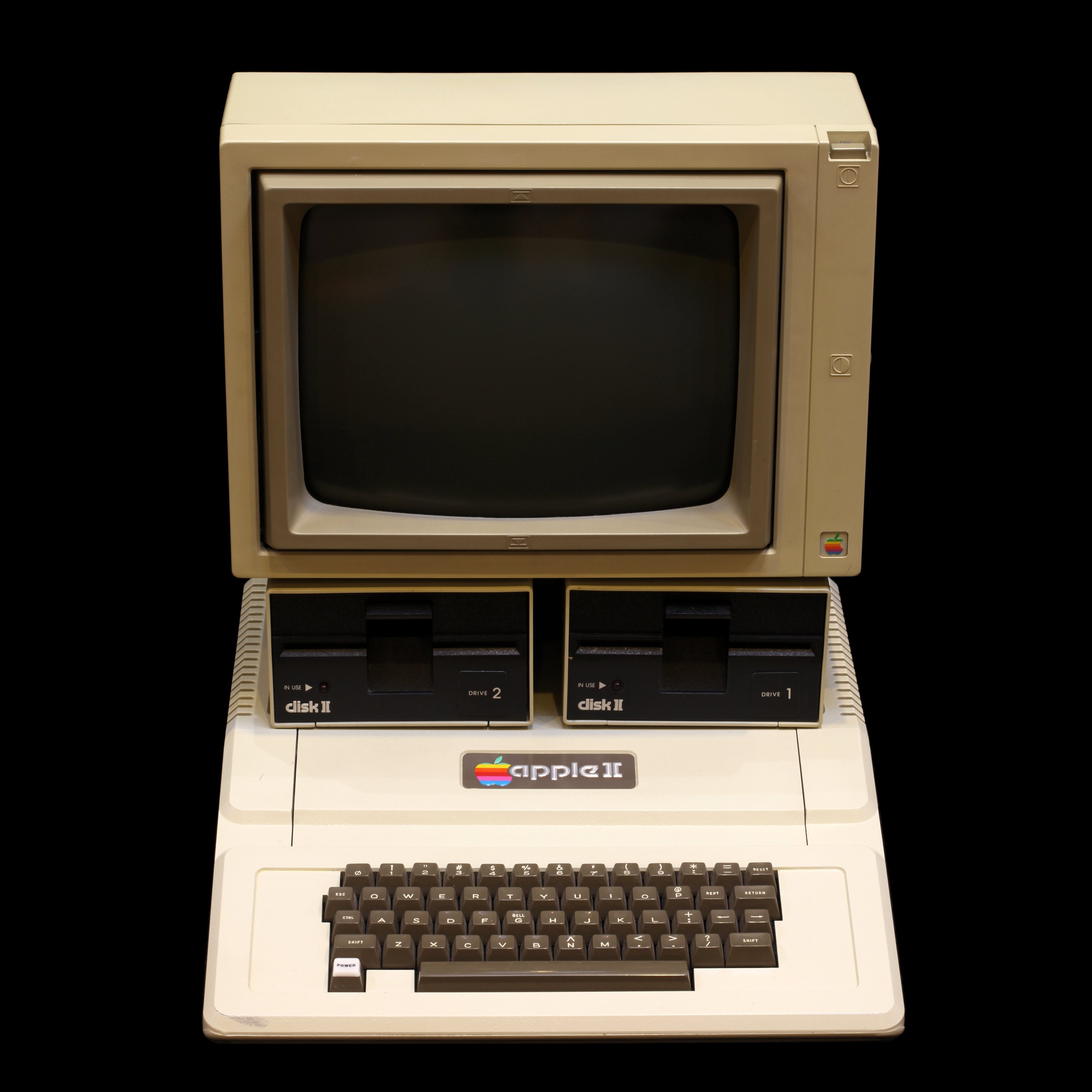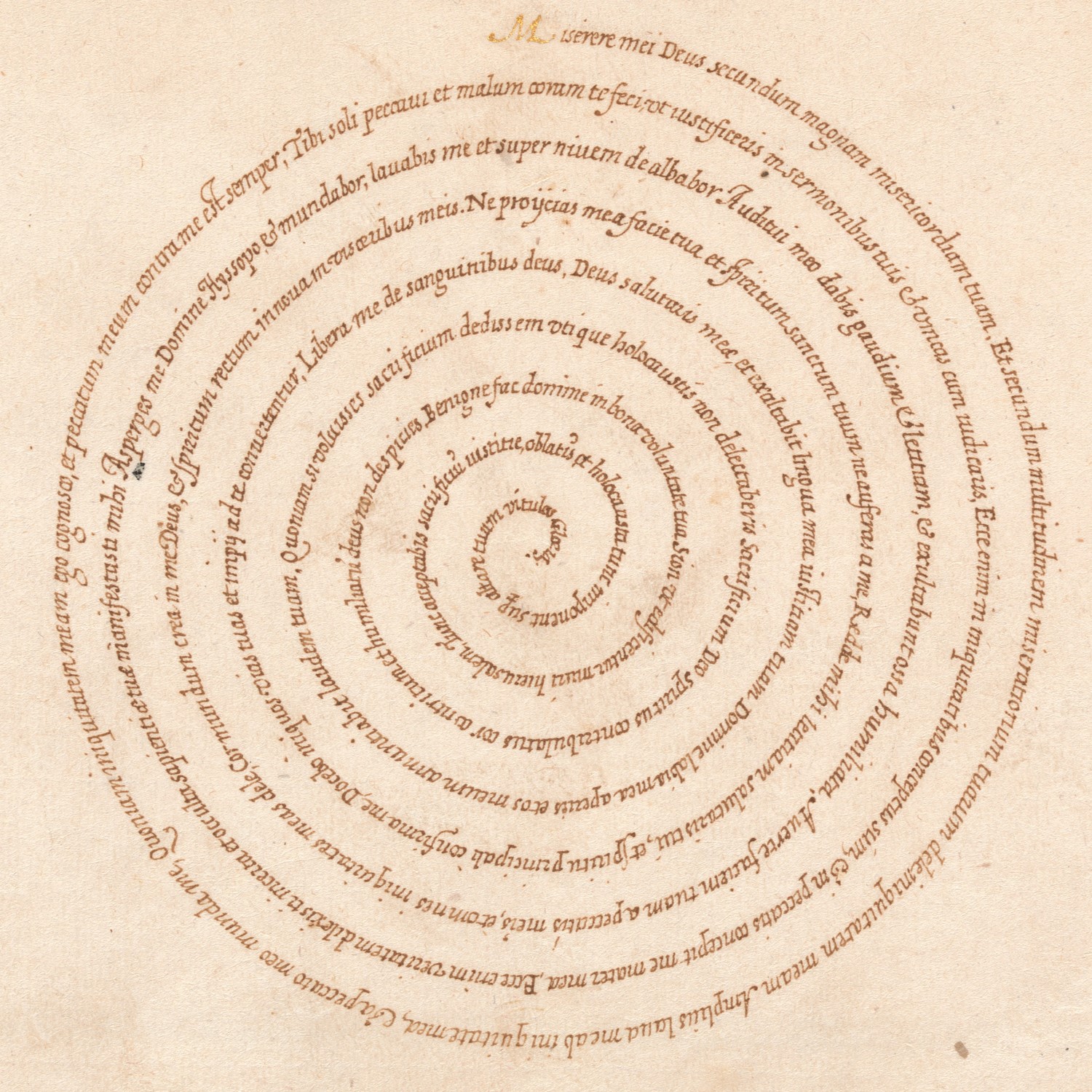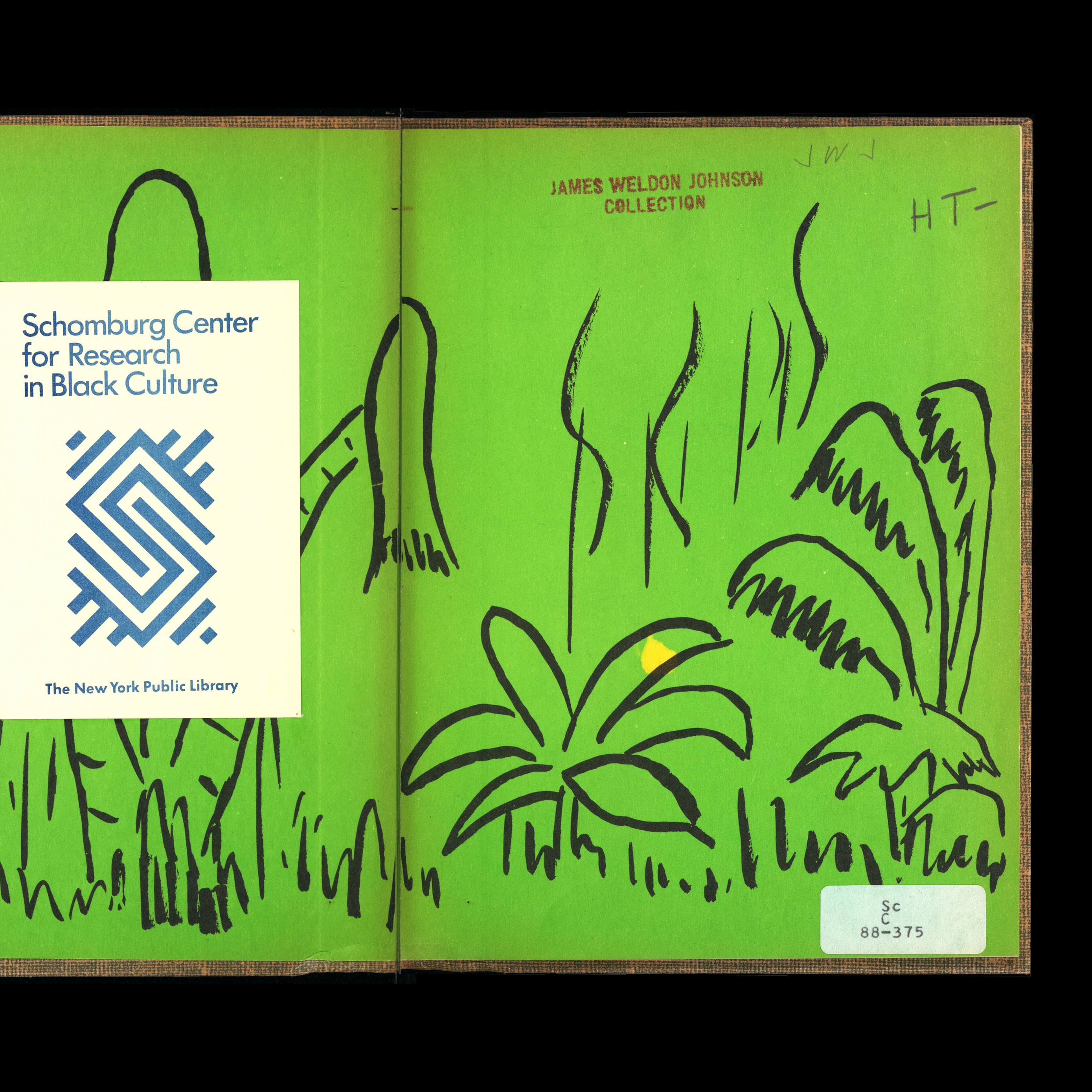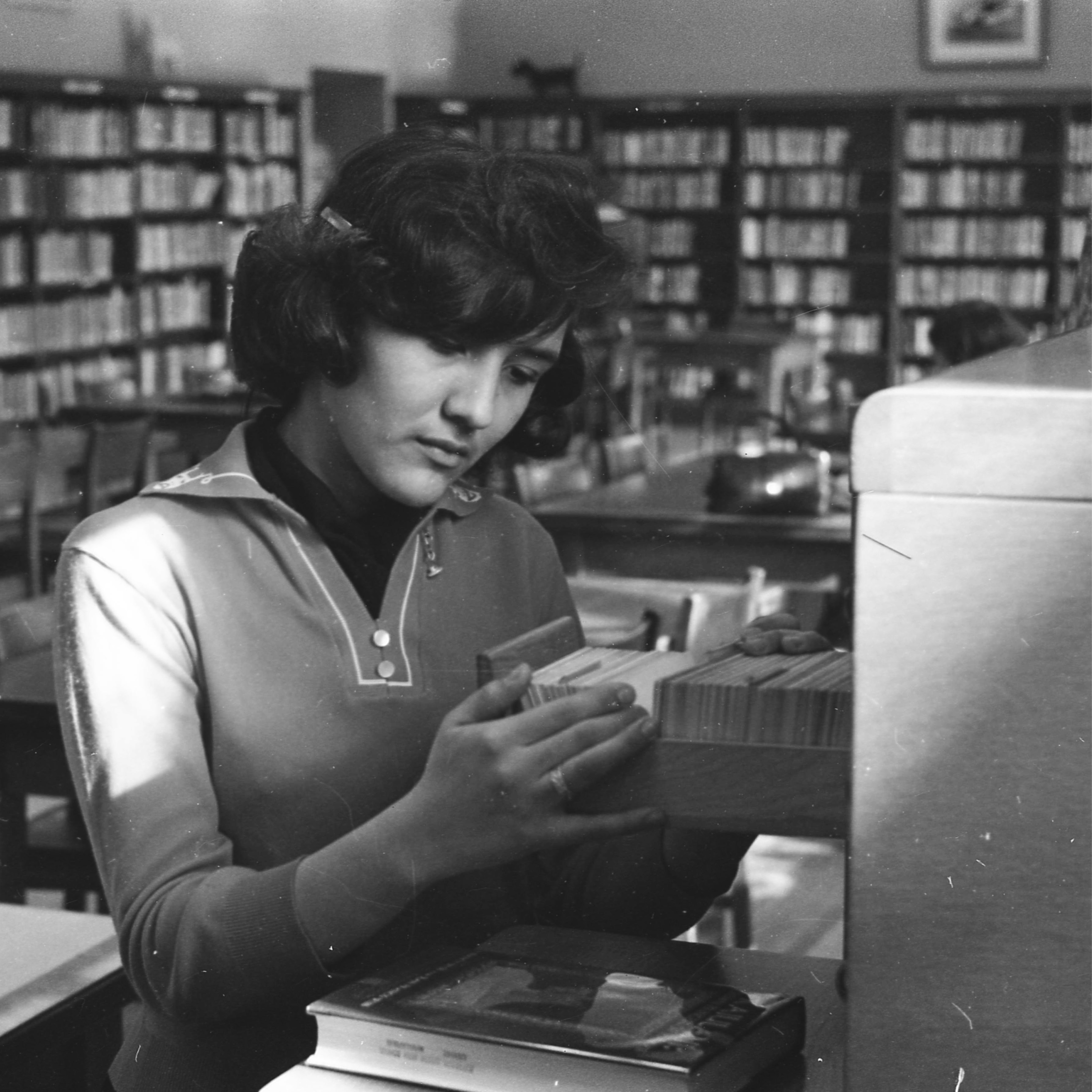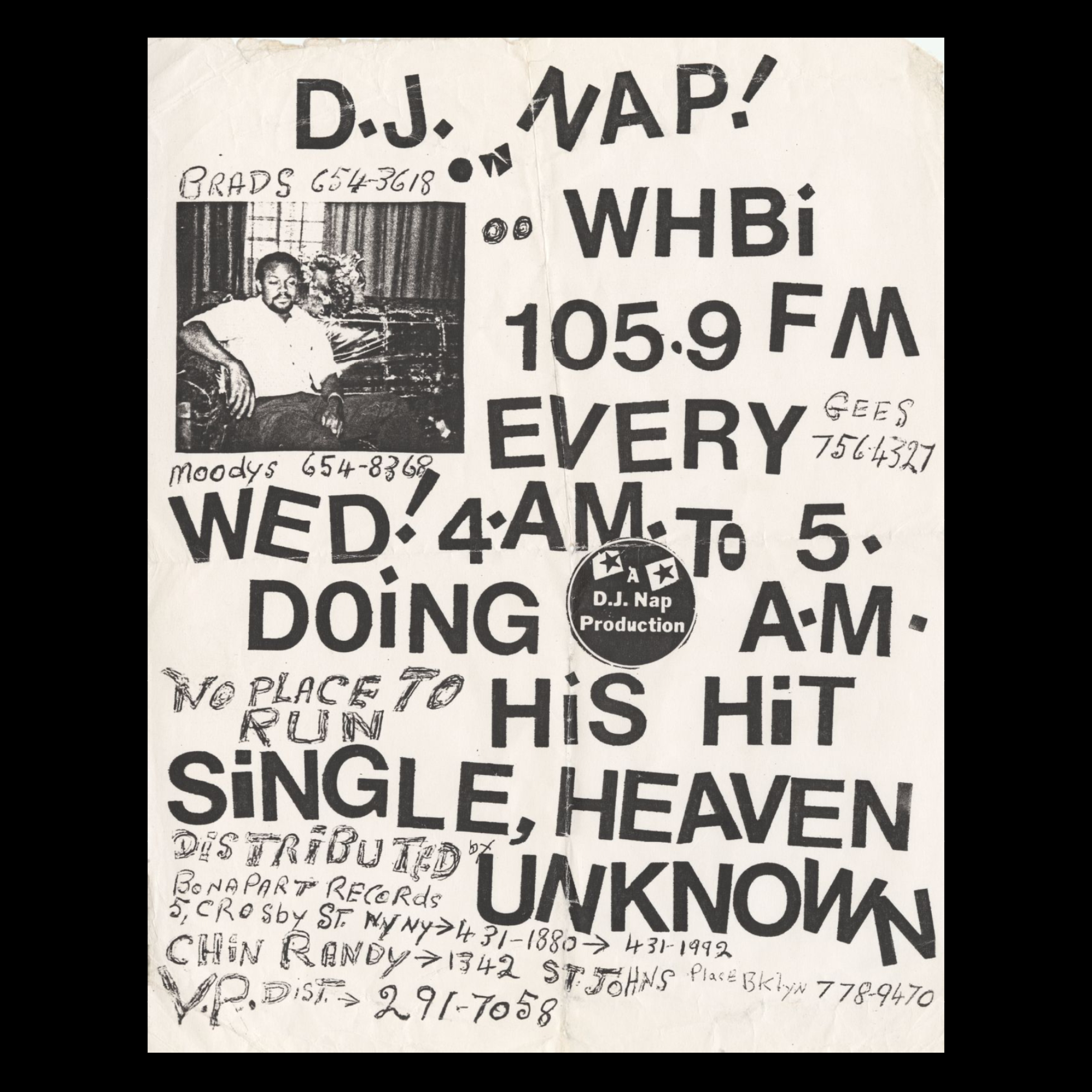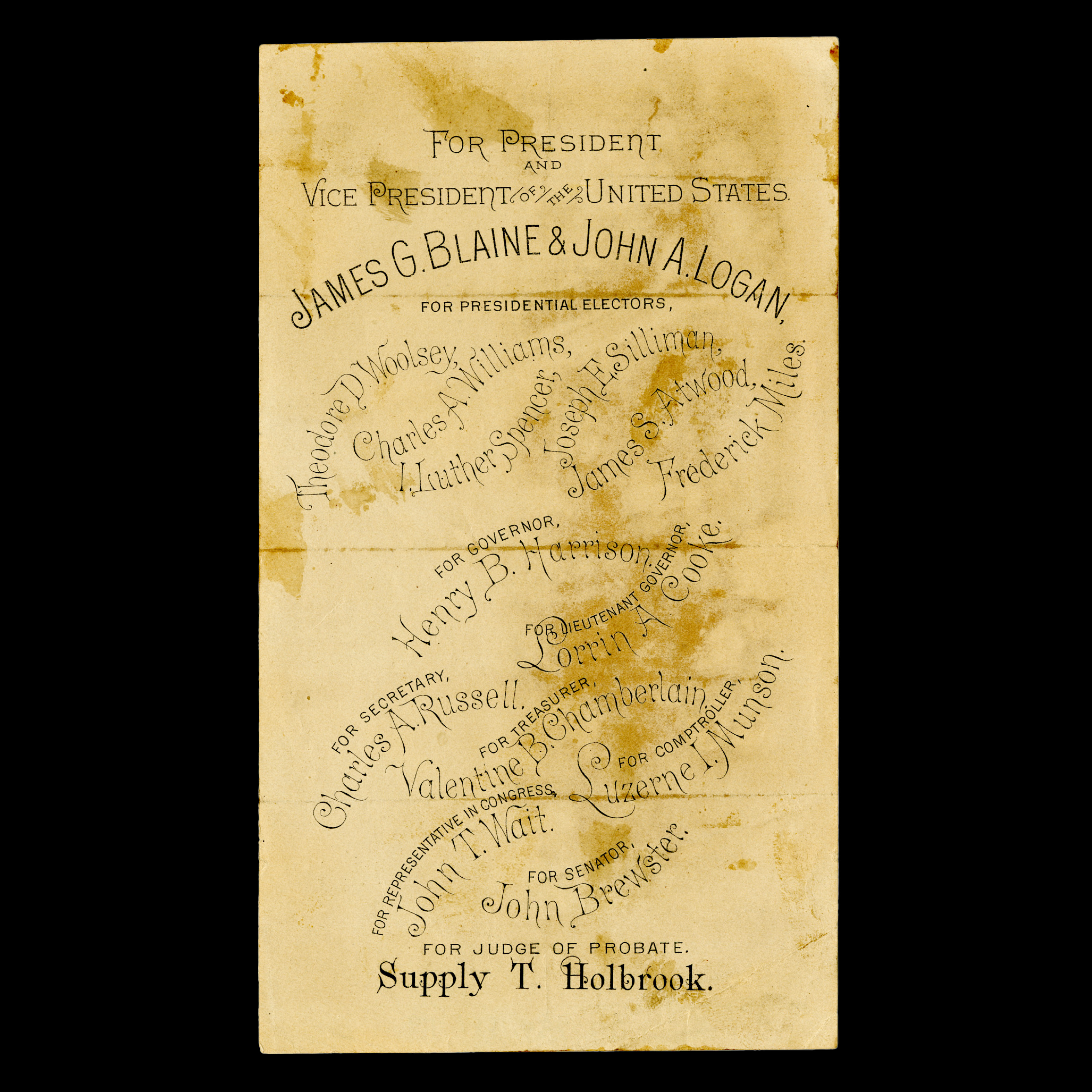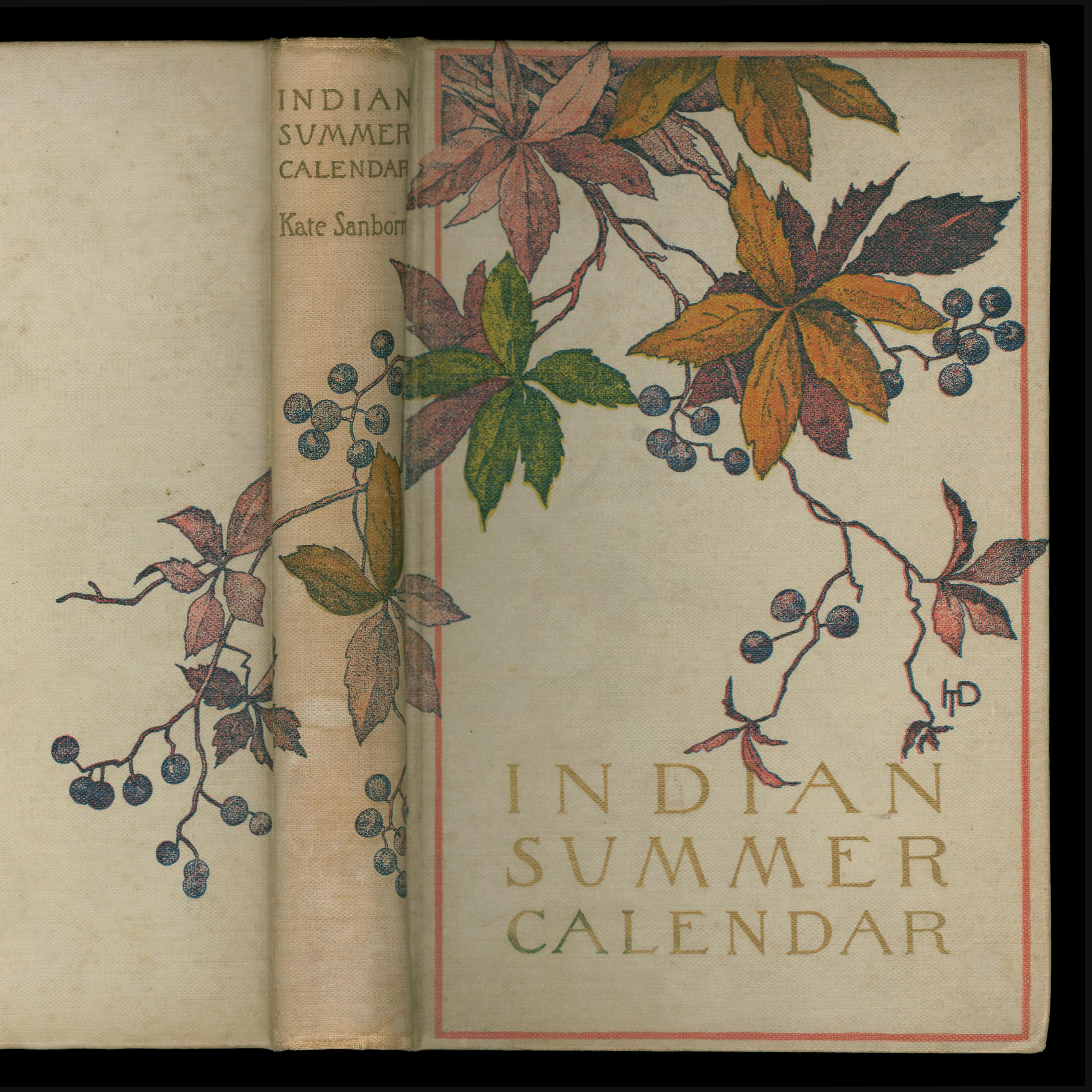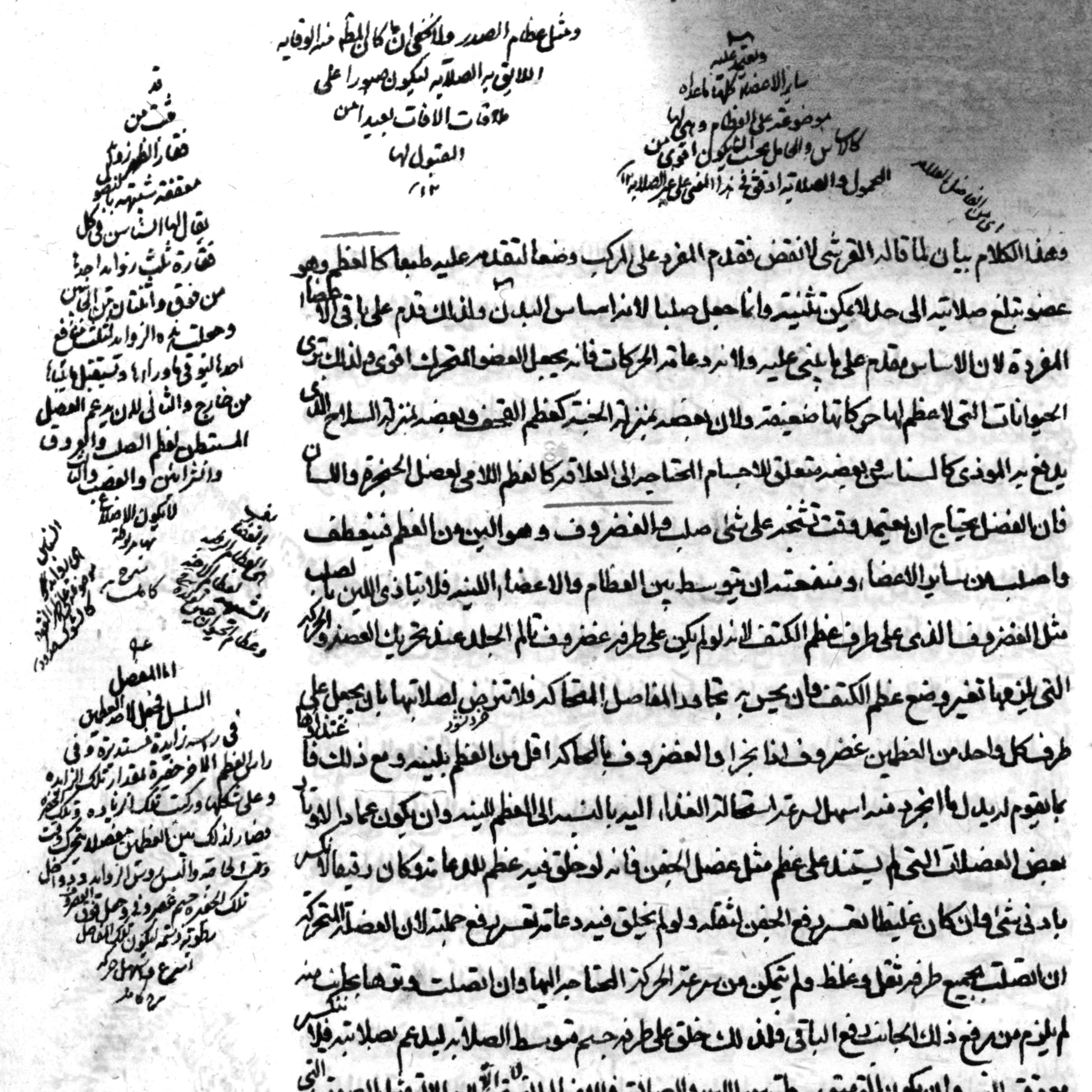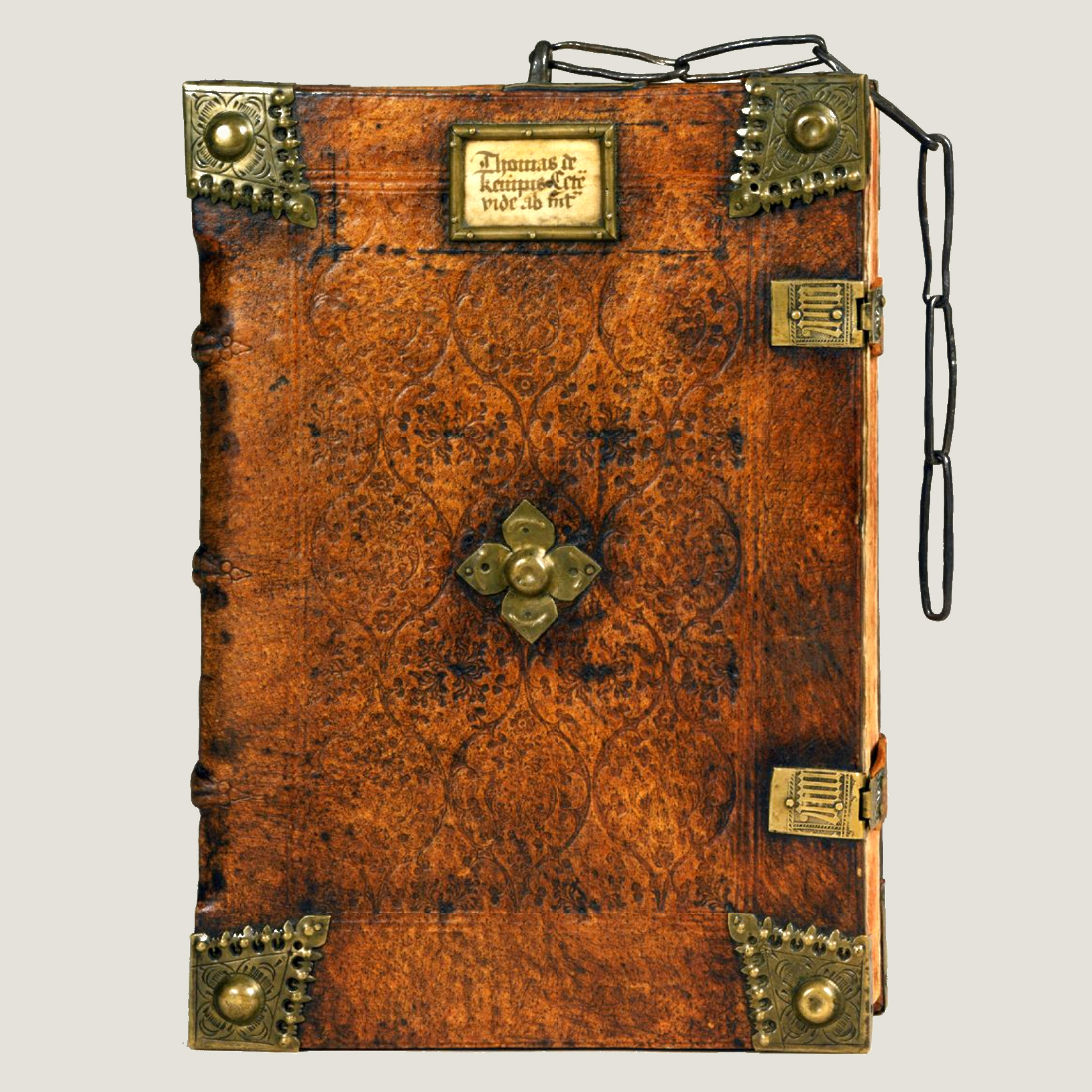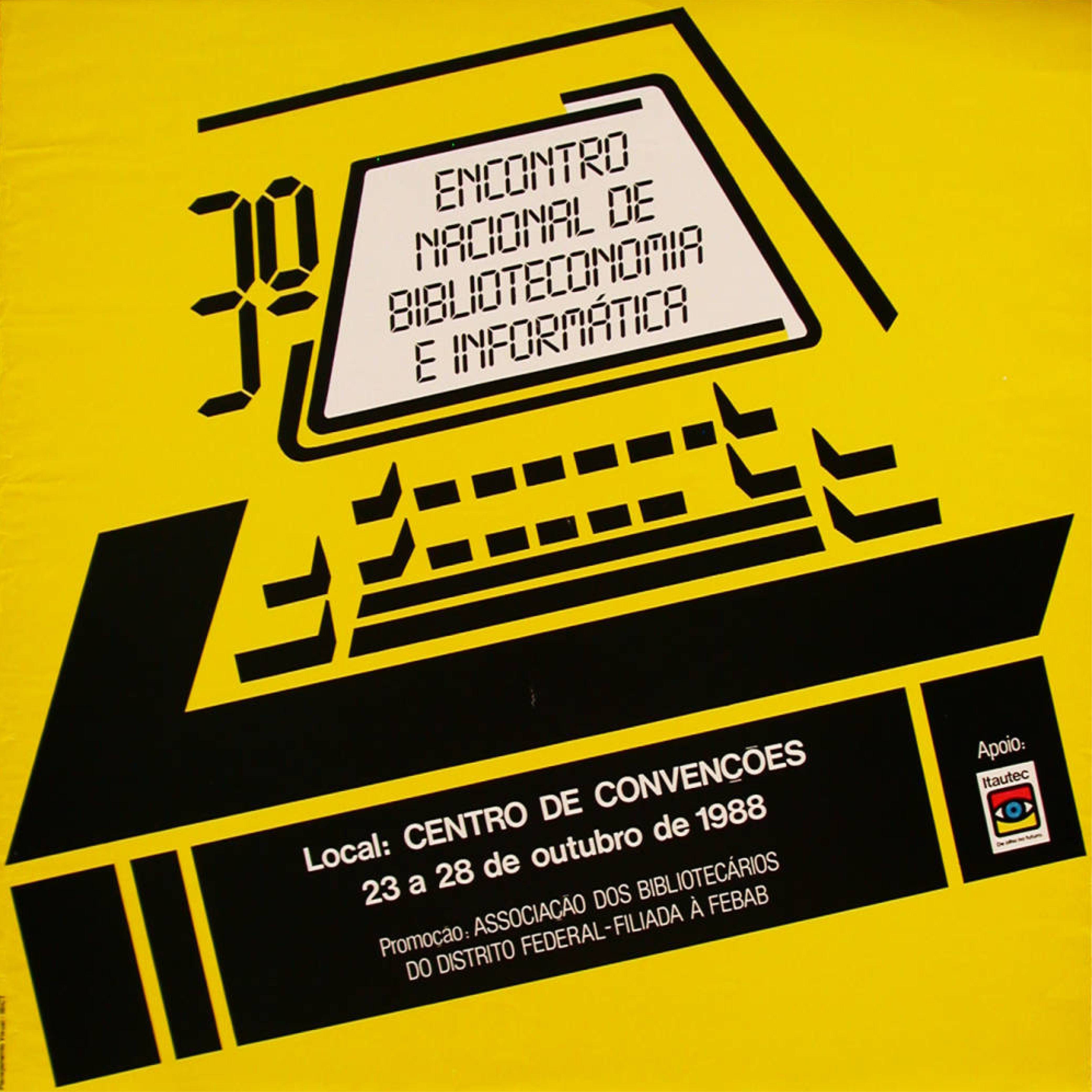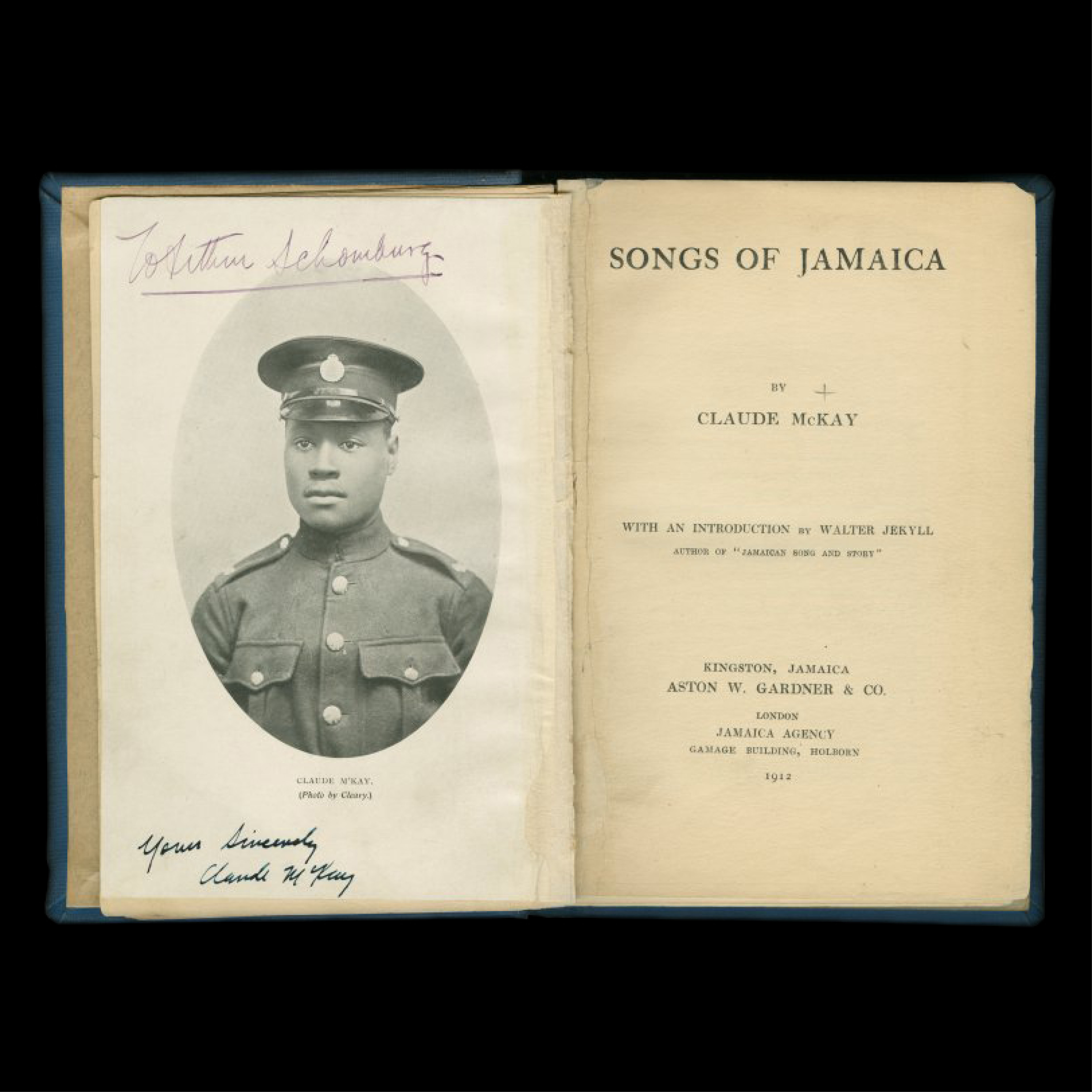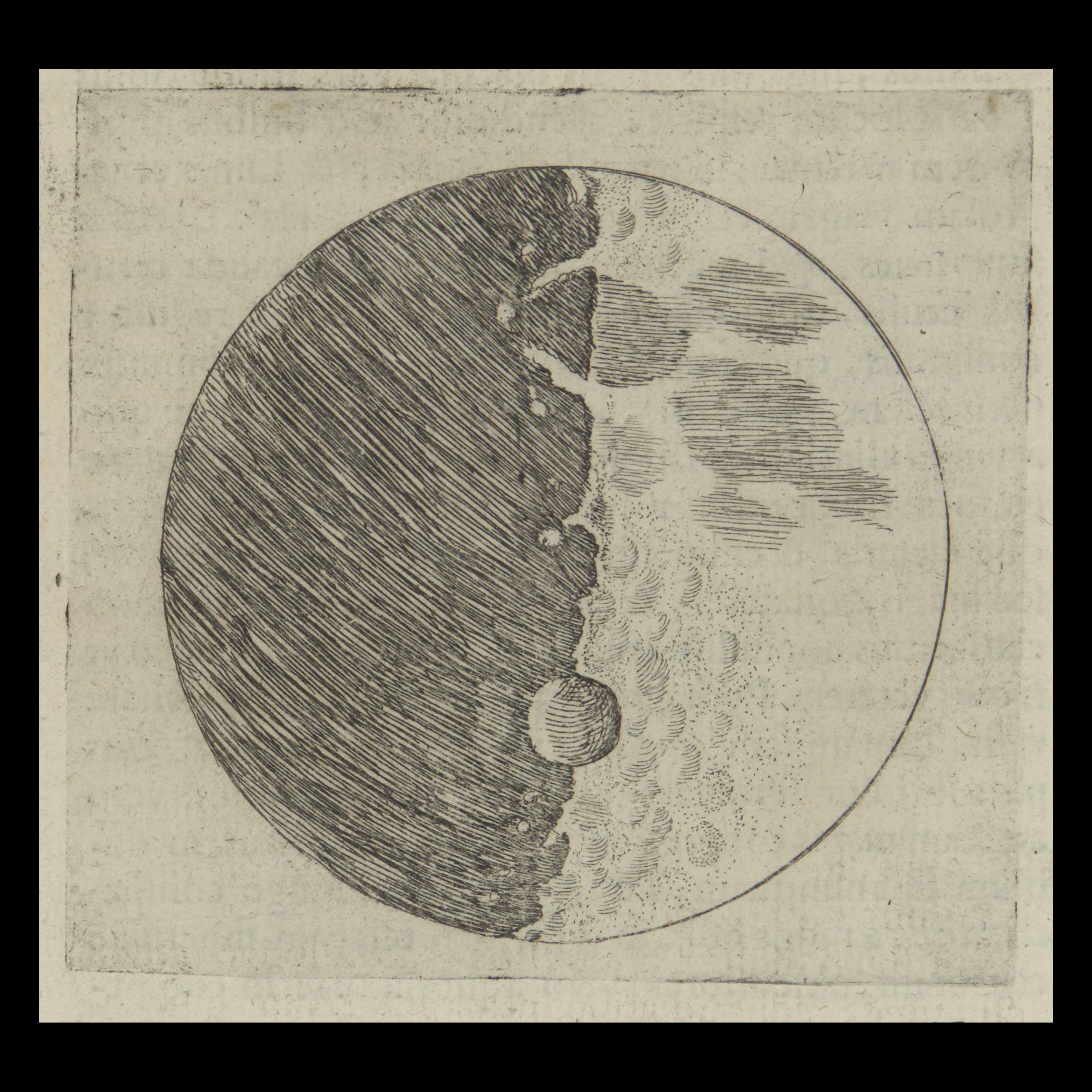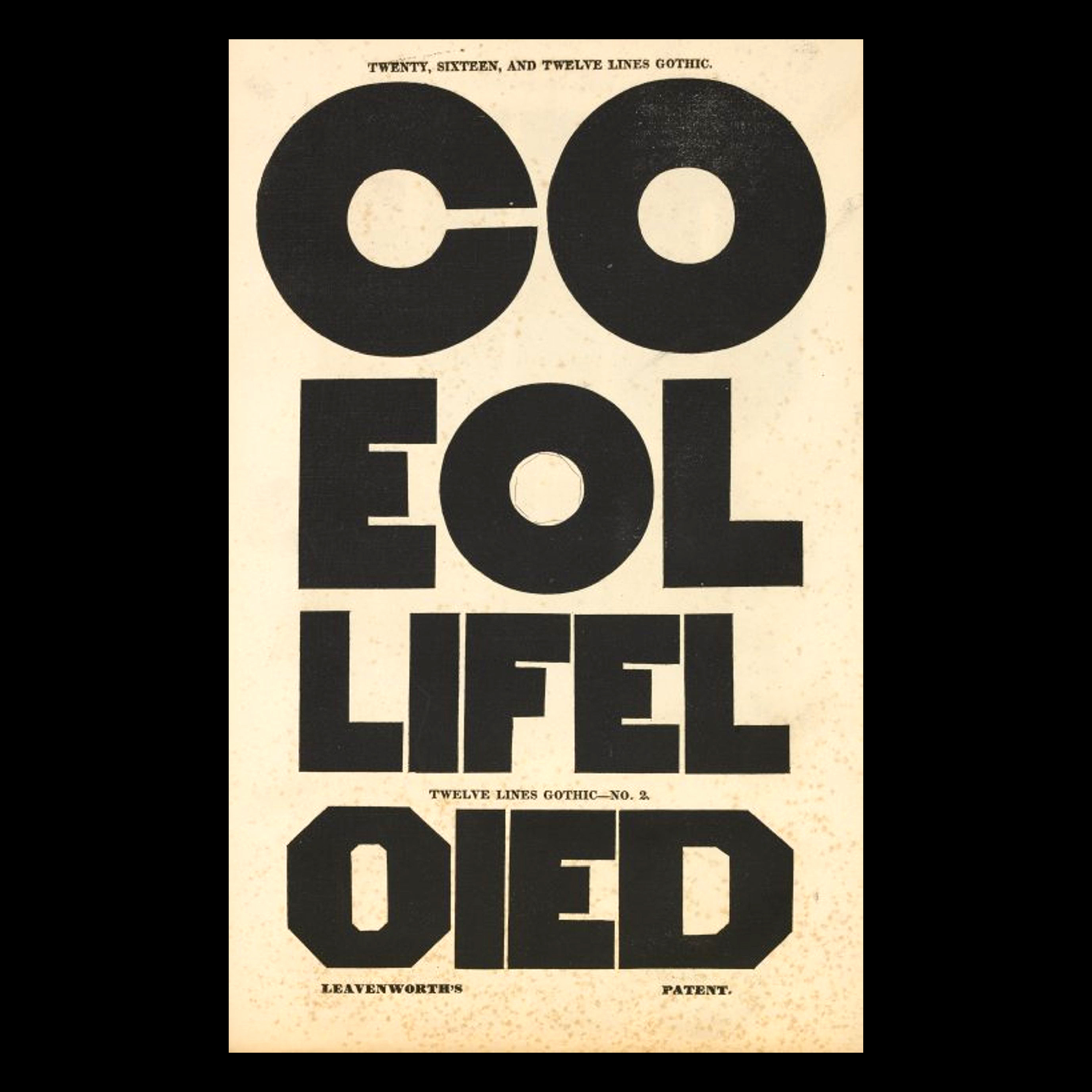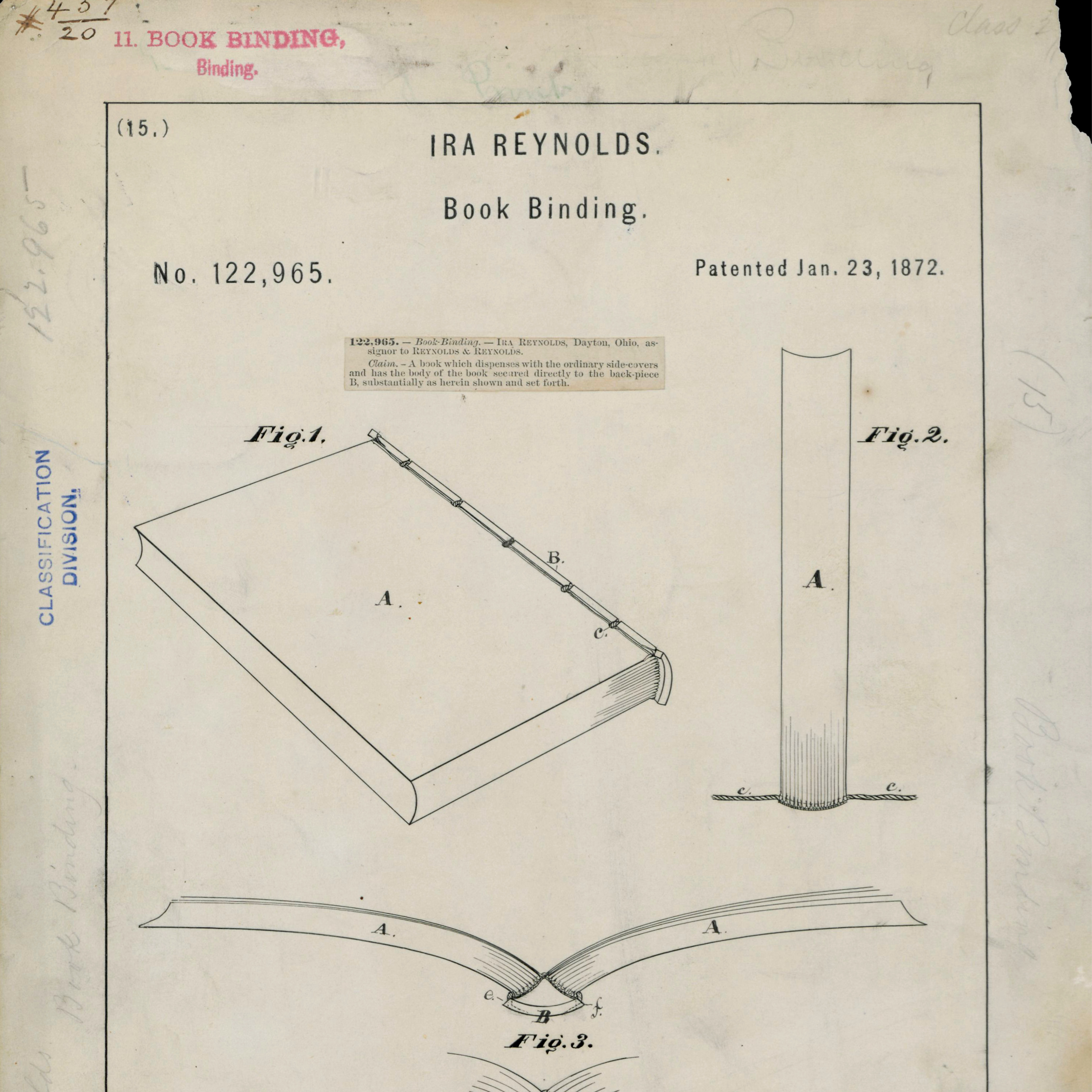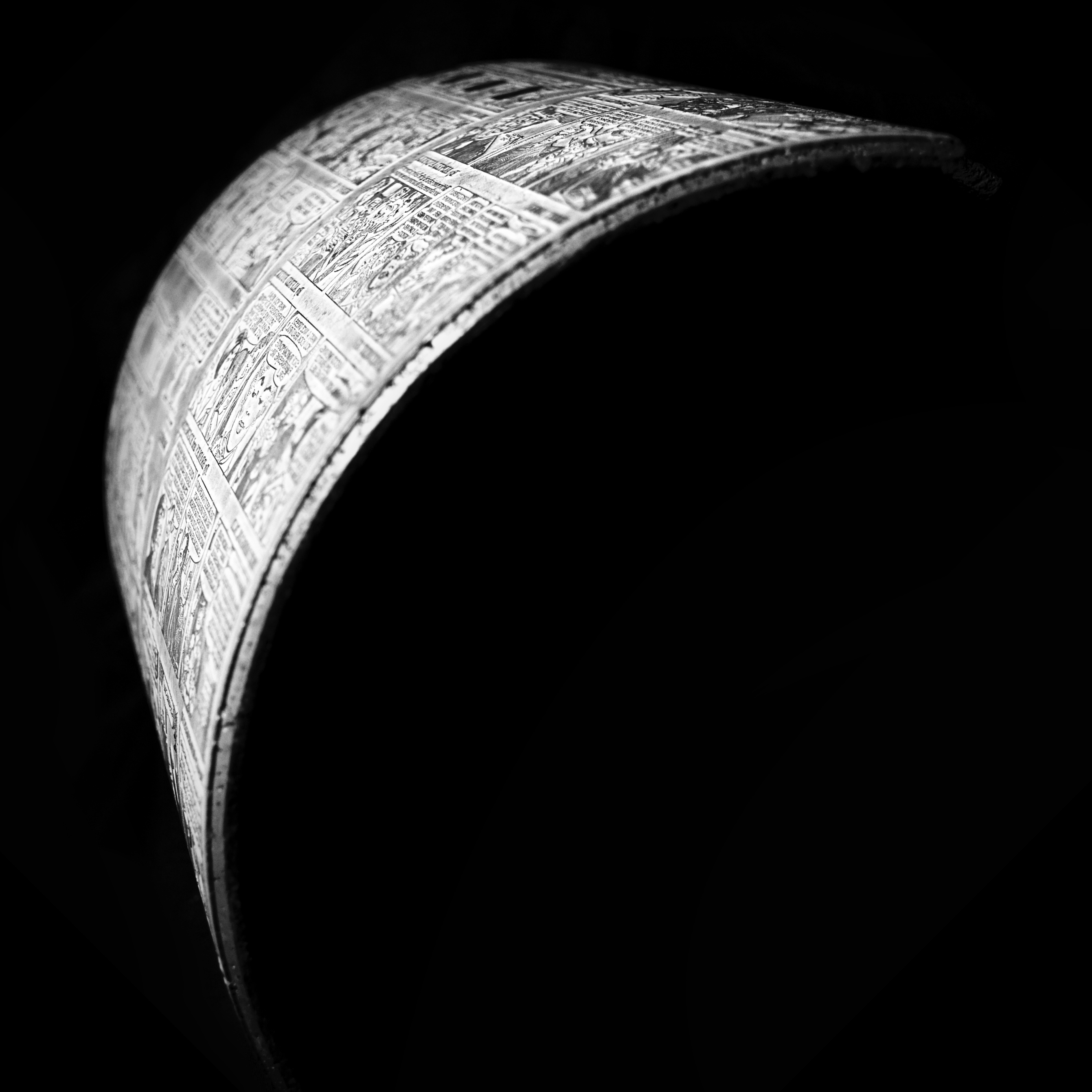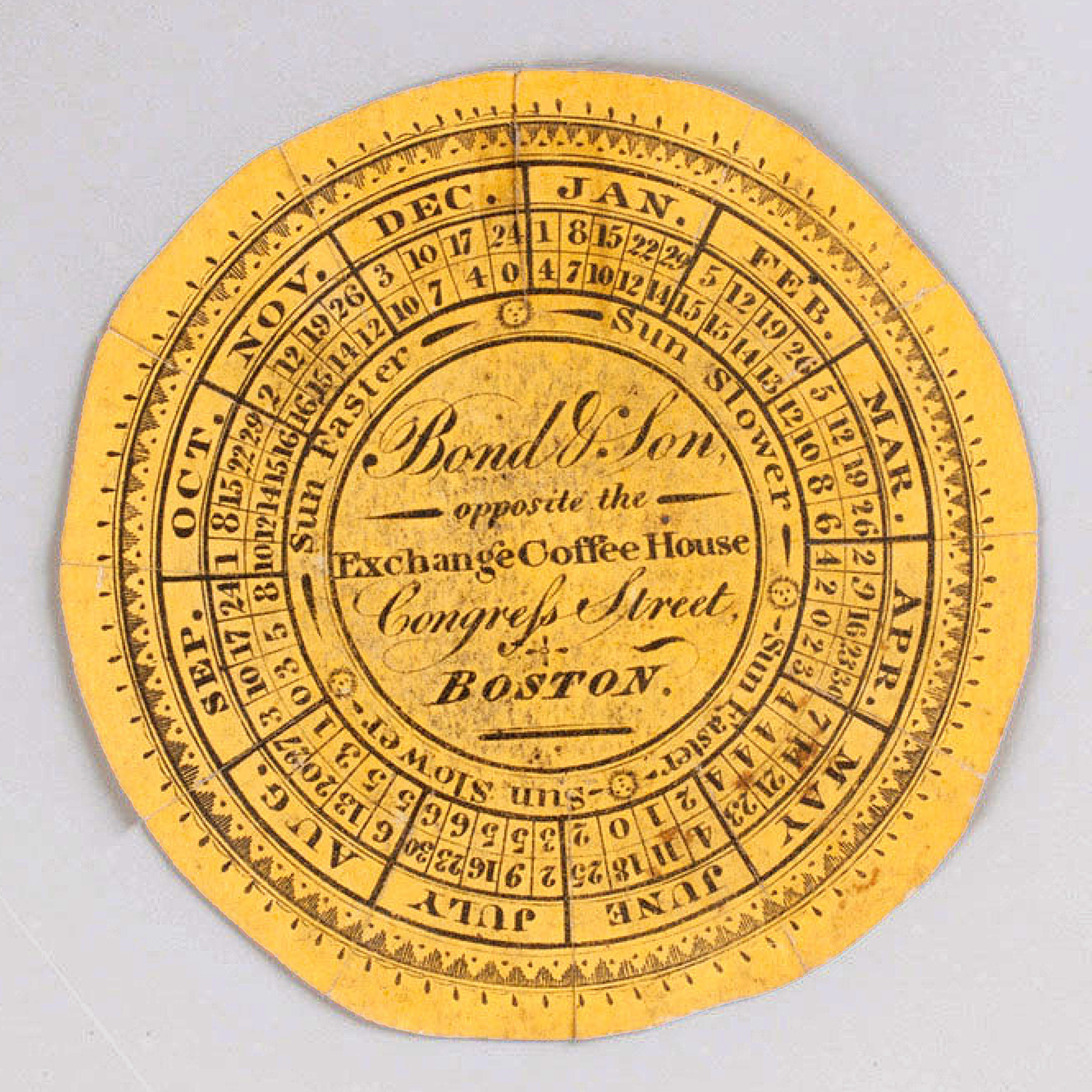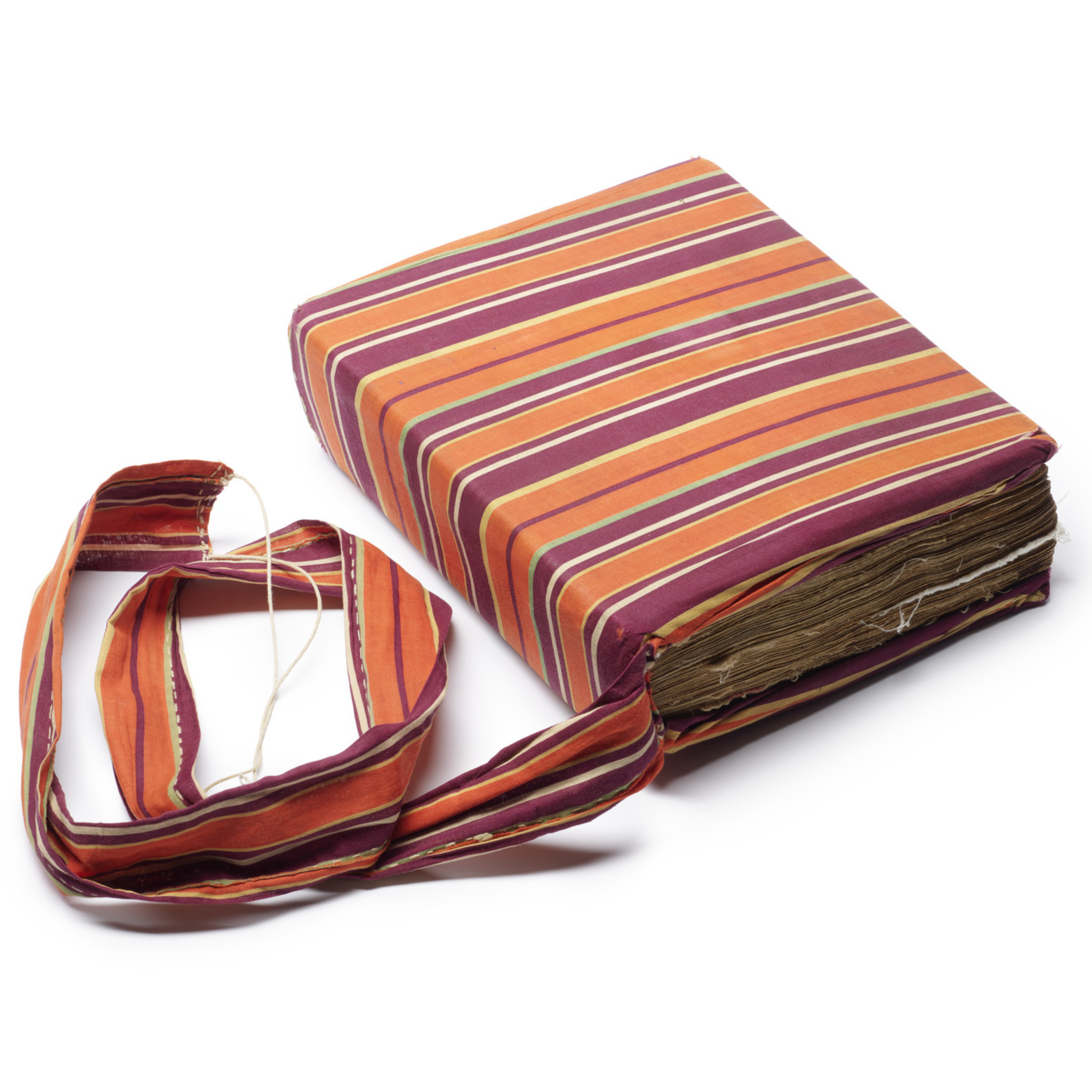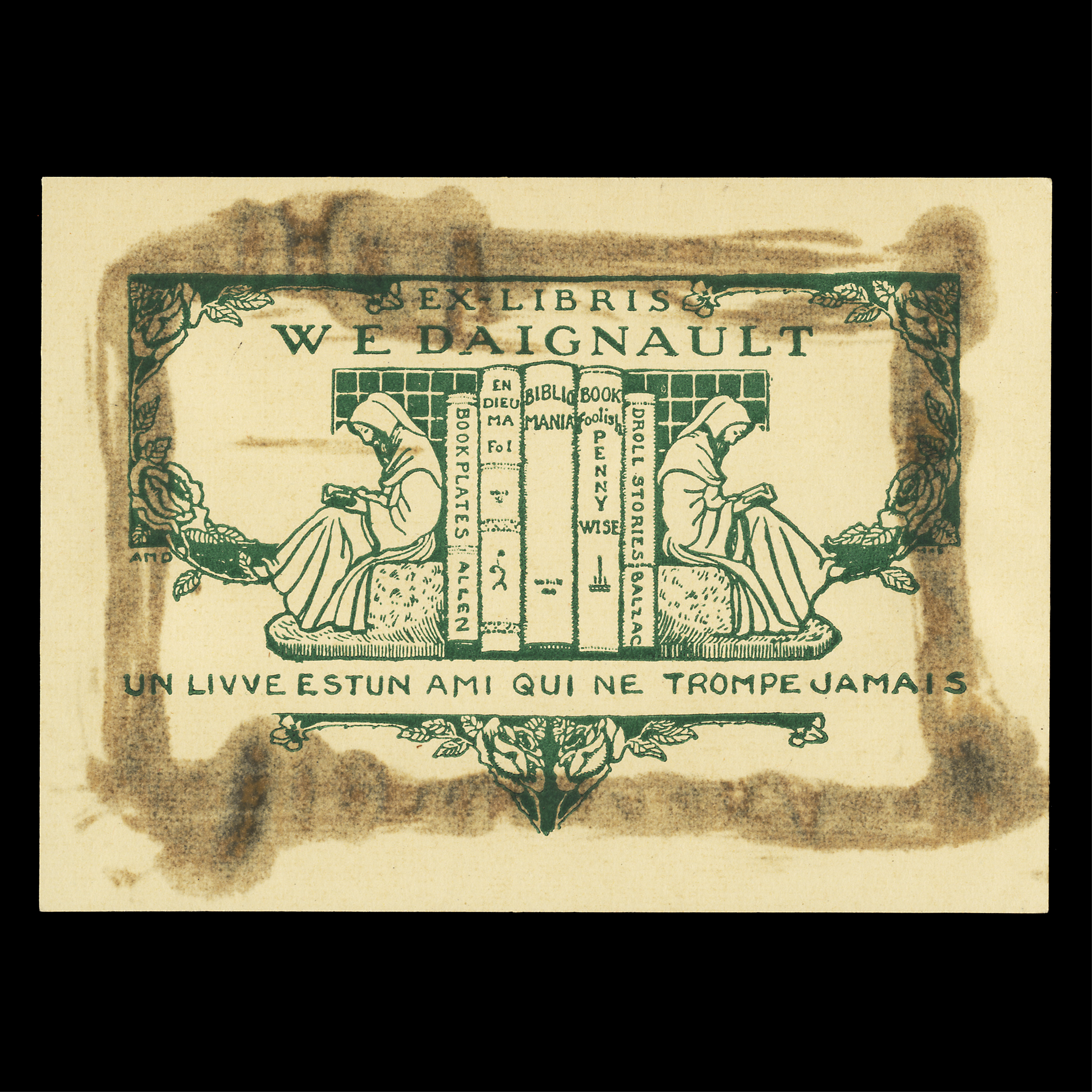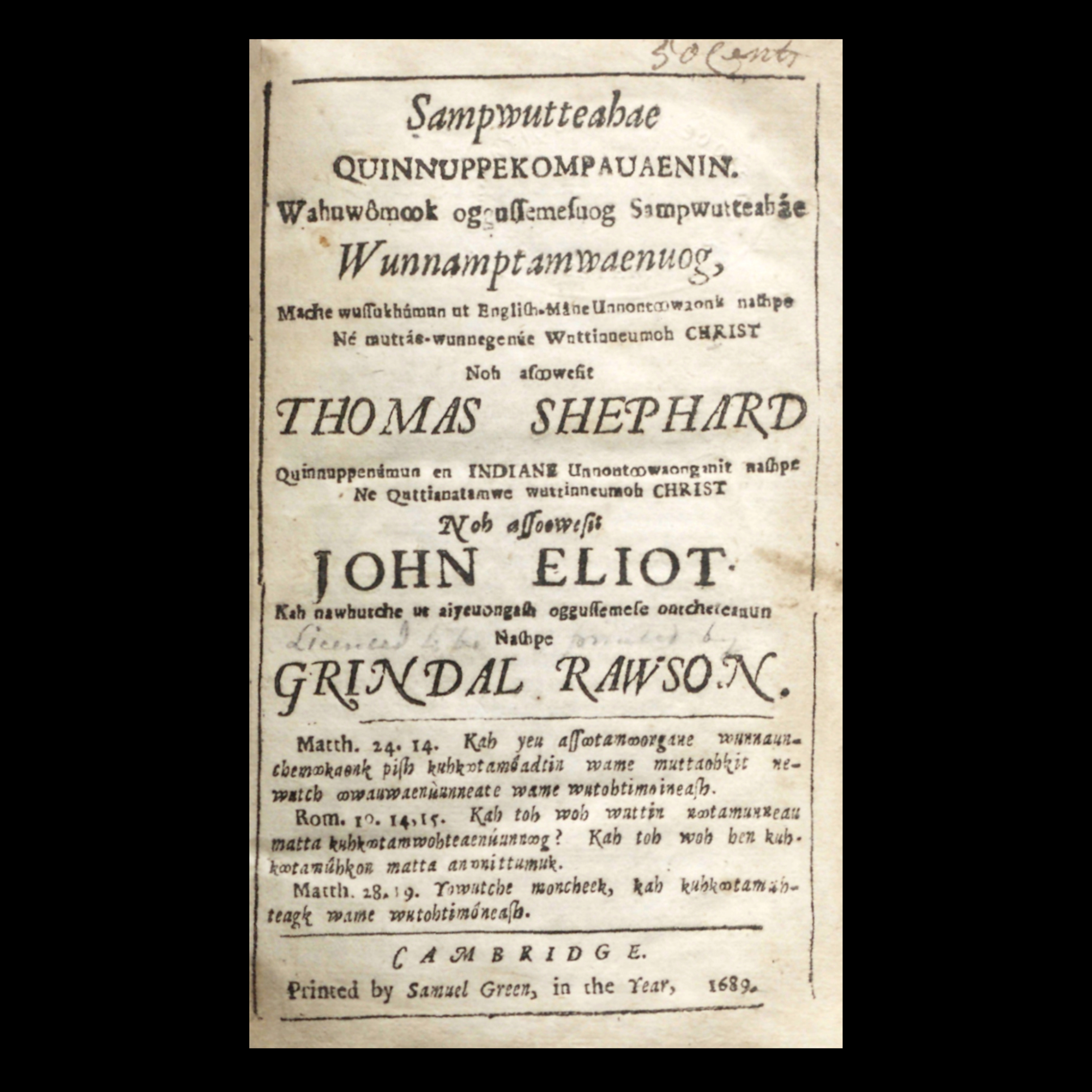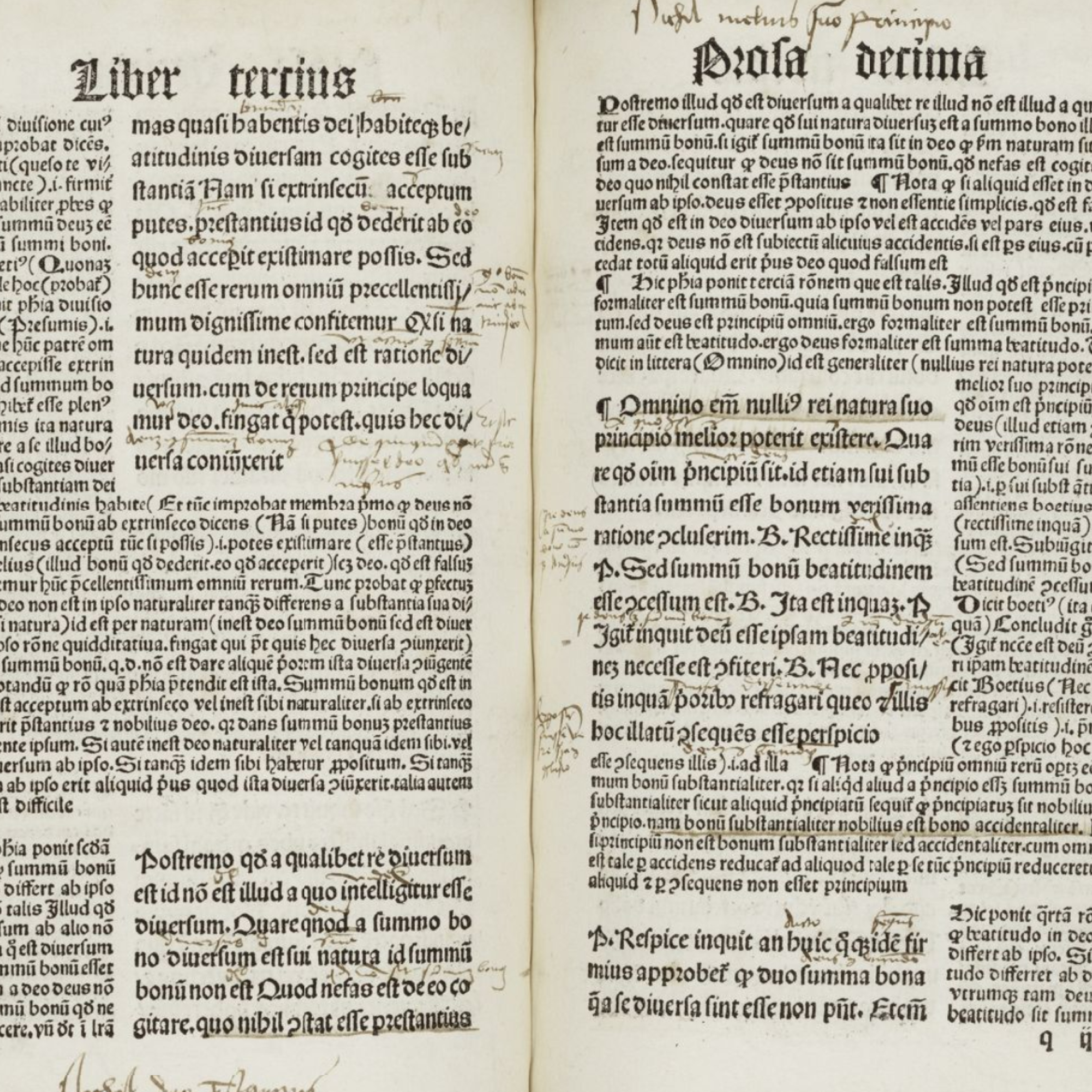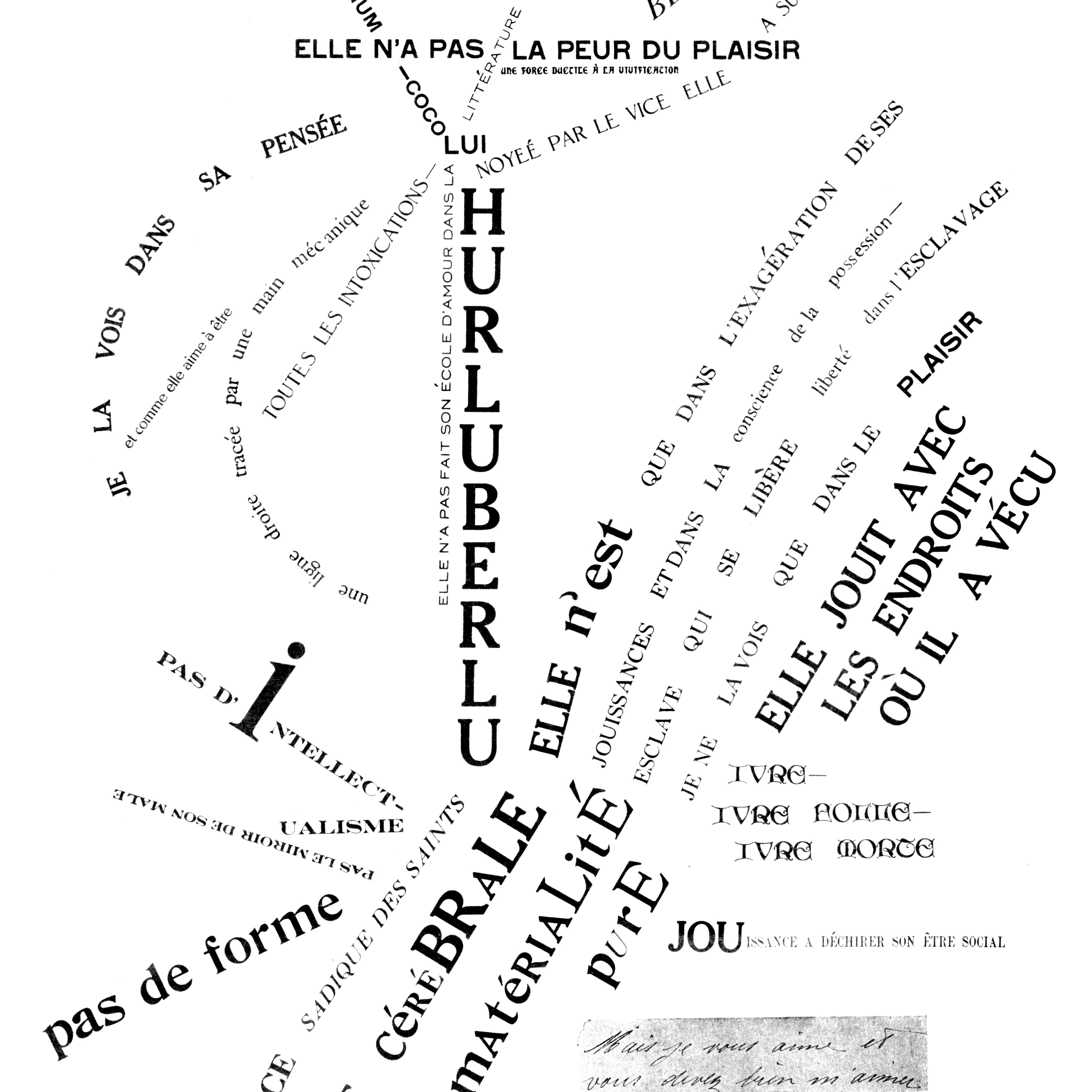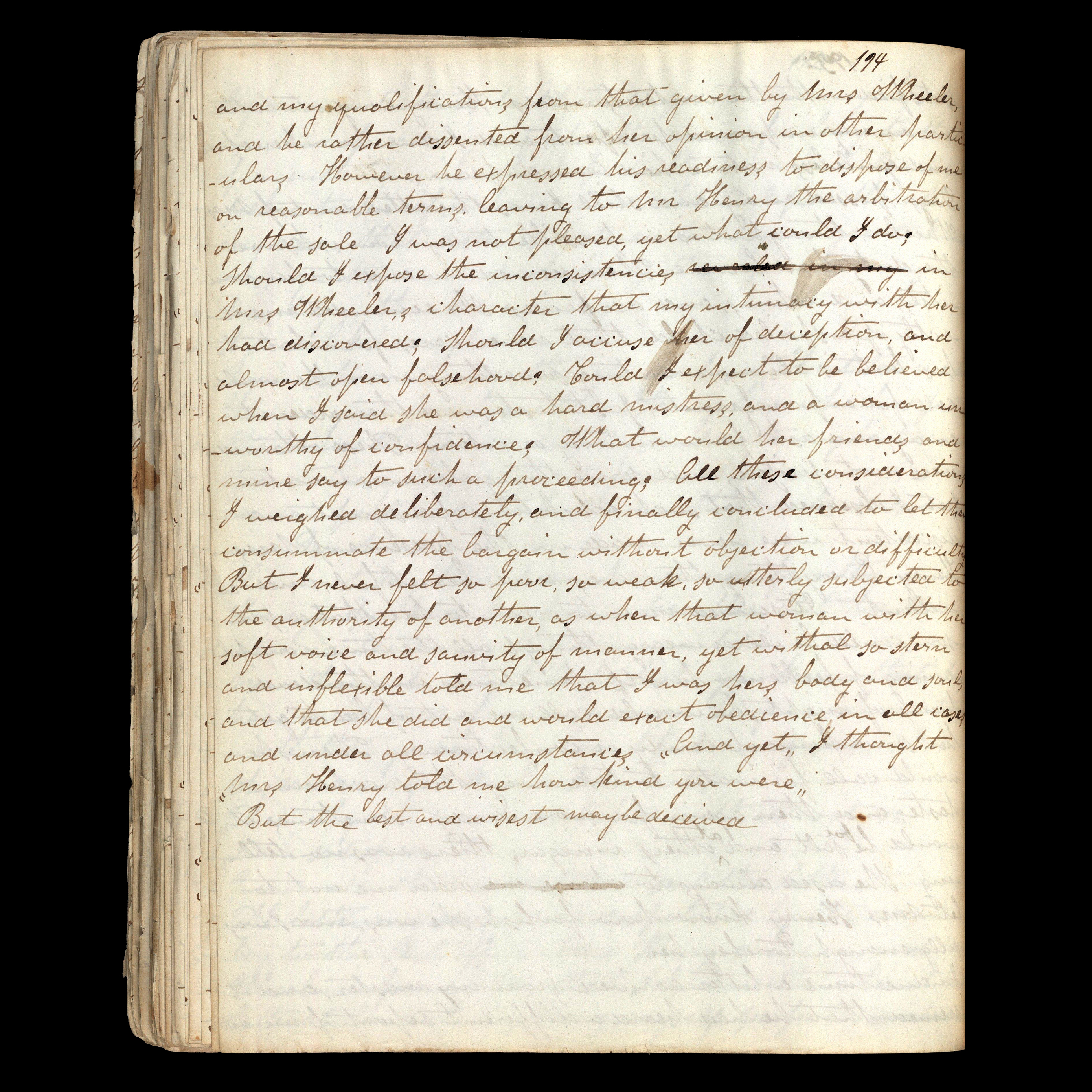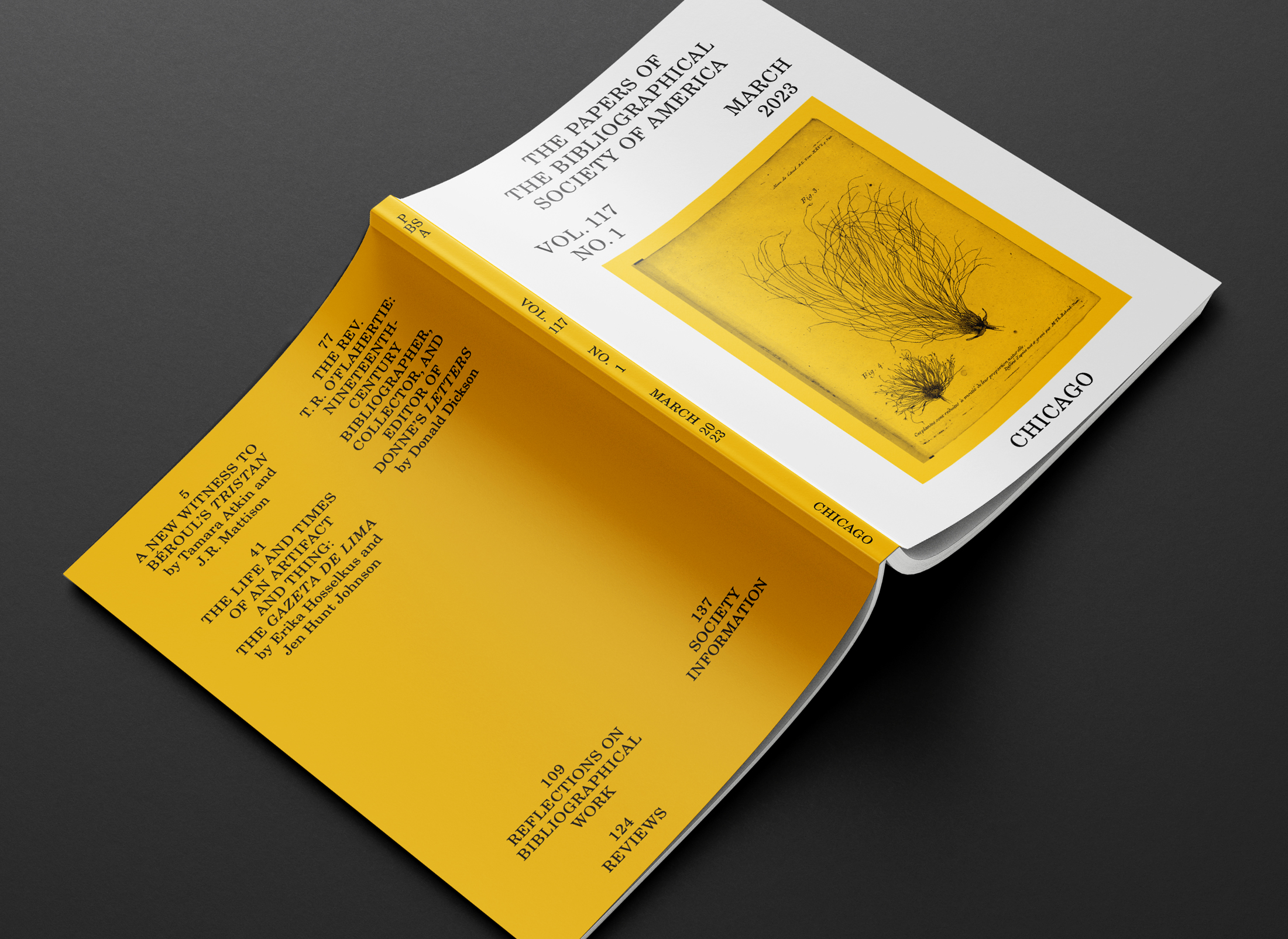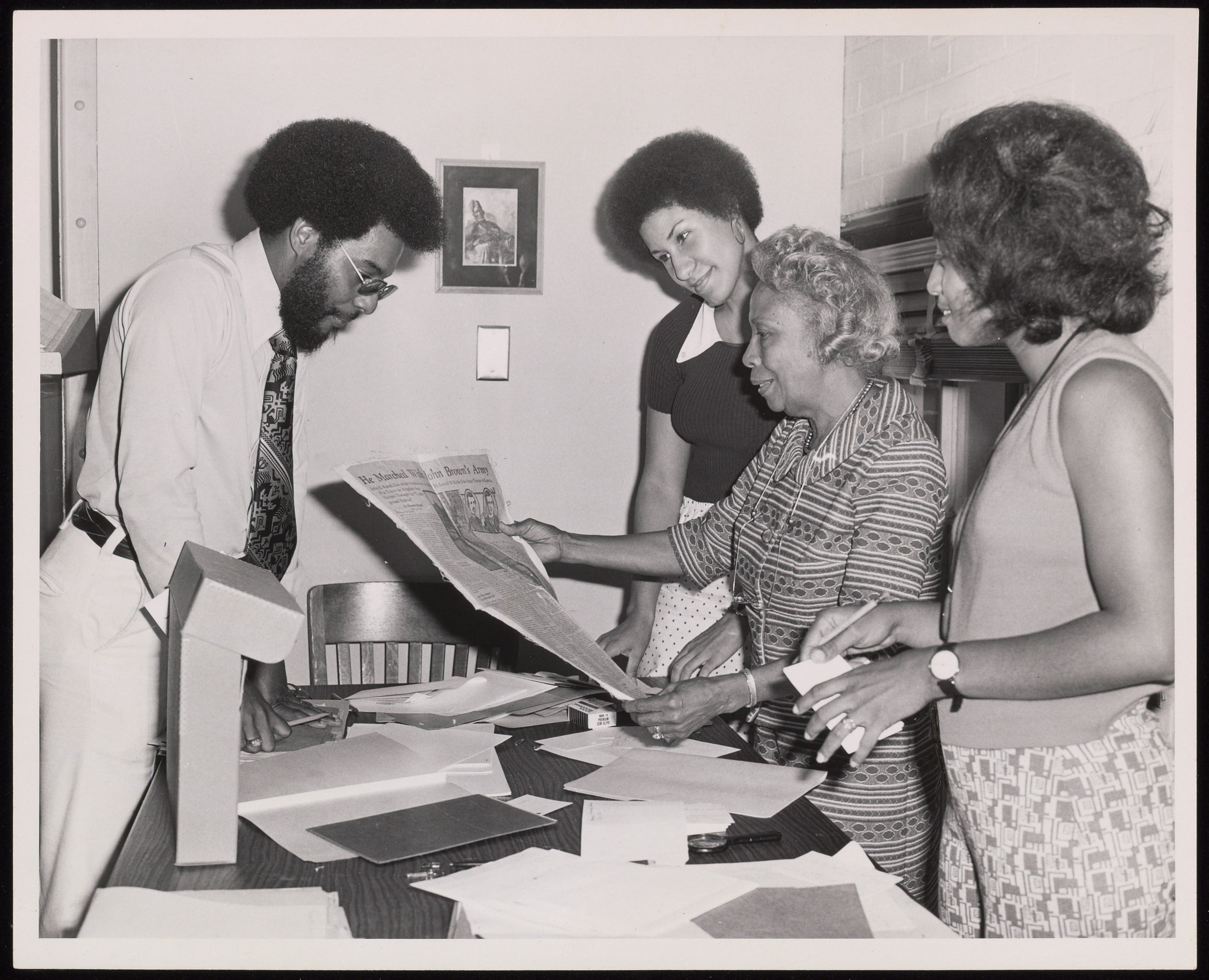Bibliographers examine the lives of texts to unlock new understandings of our global cultural heritage.
-
Kelton D-cylinder press (New York, ca. 1900). National Museum of American History, Smithsonian Institution.
-
Microfilm of Syriac Manuscripts 59, Homilies on St. John (filmed 1950; manuscript 9th century). St Catherine’s Library, Mt. Sinai, and Library of Congress.
-
Jacob Blanck, “This surely belongs in the archives…” (1962). The New York Public Library.
-
Manuscript page fragment (Islamic, 9th century CE). University of Michigan Library.
-
My tiny alphabet book (Glasgow: David Bryce & Son, ca. 1900–1930). Royal Collection Trust.
-
The book bindery, ca. 1925 (1925). University of Massachusetts Amherst Libraries.
-
Abu al-Hasan al-Shadhili, Prayer book (Turkey, 17th century). The Walters Art Museum.
-
Homilary (Lower Rhineland, 1300–1350). The Walters Art Museum.
-
Psalms 280–281 from the Manichaean Psalms (Coptic, 400). Chester Beatty Library.
-
Ibn al-Nadim, Kitab al-fihrist (Baghdad, 987–1000). Chester Beatty Library.
-
Bookbinder’s stamp (Undated). The British Museum
-
Thomas Sternhold, The whole booke of Psalmes (London: John Legat, 1639). Folger Shakespeare Library.
-
Photograph of Roxie Jarrell and Clara Hawkins, Dunbar Branch Library (Georgia, 1958). Athens-Clarke County Library.
-
Patent model for a web perfecting rotary press (Luther C. Crowell, ca. 1879). National Museum of American History, Smithsonian Institution.
-
C.S. Van Winkle, Supplement to the Catalogue of the Books Belonging to the New-York Society Library (New York, 1825). New York Society Library.
-
Ostrakon with lines from Homer’s Iliad (Coptic, 580–640). The Metropolitan Museum of Art.
-
Microfilm Publications and Documentation (1955). US National Archives.
-
Emil Schulthess, Africa (Simon and Schuster, 1959). Schomburg Center for Research in Black Culture, New York Public Library.
-
Cuneiform tablet of a private letter (Anatolia, ca. 20th–19th century BCE). The Metropolitan Museum of Art.
-
Punch cards in the style of Charles Babbage (Italy, ca. 1840) National Museum of American History, Smithsonian Institute.
-
Kenneth F. Space, “Fisk University, Students at Library Card Catalog” (Tennessee, 1936–1937). US National Archives.
-
Pastedown in Petrus de Natalibus, Catalogus sanctorum et gestorum eorum ex diversis voluminibus collectus (Vicenza, 1493). Boston Public Library.
-
Patent, Robert C. Morris Manifold-Writing Tablet (1879). University of North Texas Libraries.
-
“Mrs. Man Hing Mok, head of UCLA Oriental Library holding ancient Tibetan manuscript-scroll, 1964” (Los Angeles Times, 1964). © UCLA Library Special Collections.
-
“Stark Street Library Reference Room” (Portland, OR, 1900–1909). Multnomah County Library Historical Photographs Archive.
-
Ludger tom Ring the Younger (attrib.), The Open Missal (Germany, ca. 1570). Frances Lehman Loeb Art Center, Vassar College.
-
Apple II computer (ca. 1977). CC BY-SA image by Rama of an item in the Musée Bolo.
-
Codex Mendoza detail (Mexico, ca. 1541). CC BY-NC image from Bodleian Libraries, University of Oxford.
-
Micrographic design in the shape of a spiral (France or Belgium, early 17th century). The Metropolitan Museum of Art.
-
Jean Ketchum, Stick-in-the-Mud: A tale of a village, a custom, and a little boy (W. R. Scott, 1953). Schomburg Center for Research in Black Culture, New York Public Library.
-
“Using the Library Card Catalog” (Minneapolis, 1963). Hennepin County Library.
-
Photograph of Mr. M. Siddiq at Photostat Machine (1954). US National Archives.
-
“D. J. Nap! WHBI 105.9FM” (New York, n.d.). Image provided under an educational license by Cornell University Library.
-
Ballot for the 1884 Presidential election (1884). National Museum of American History.
-
Kate Sanborn, Indian Summer Calendar (Case, Lockwood, and Brainard Company, 1904). University of Wisconsin—Madison Libraries.
-
Hartmann Schedel, Liber chronicarum (Nuremberg: Anton Koberger, 1493). Folger Shakespeare Library.
-
Ibn al-Nafis, Compendium of the Canon of Medicine (Cairo, ca. 1240–1288) Qatar National Library via the Library of Congress.
-
Opening page of calendar for the month of January (Bruges, 1425–1450). New York Public Library.
-
Thomas à Kempis, Opera et libri (Nuremberg: Kaspar Hochfeder, 1489). Folger Shakespeare Library.
-
3o Encontro nacional de biblioteconomia e informática (Brazil, 1988). © University of New Mexico.
-
Claude McKay, Songs of Jamaica (Jamaica Agency, 1912). The New York Public Library.
-
Galileo Galilei, Sidereus nuncius (Venice: Tommaso Baglioni, 1610). Library of Congress.
-
Bernhard von Breydenbach, Peregrinatio in terram sanctam (Mainz: Erhard Reuwich, 1486). Library of Congress.
-
“Twenty, sixteen, and twelve lines gothic,” Specimen of Leavenworth’s patent wood type (Allentown, NJ: 1840–1849). New York Public Library.
-
Patent, Ira Reynolds Book Binding (1872). US National Archives.
-
Newspaper printing plate for comics page (n.p., 17 July 1976). CC BY-NC image by Glenn Fleishman.
-
Bond & Son watch paper (Boston, ca. 1840). American Antiquarian Society.
-
Watermark of a flower (Briquet 6394; Bamberg?, 1446). Briquet Online.
-
Zämänfäs Qeddus, Gondar Homiliary (Ethiopia, late 17th century). The Walters Art Museum.
-
Anne M. Danielsen, Bookplate of W.E. Daignault. (Undated). University of Illinois Library.
-
Sampwutteahae Quinnuppekompauaenin (Cambridge, MA: Samuel Green, 1689). American Antiquarian Society.
-
Boethius, De consolatione philosophiae (Cologne: Heinrich Quentell, 1497). Folger Shakespeare Library.
-
Scriptores rei militaris, Strategematica (Bologna: Francesco Benedetti, 1495–1496). Folger Shakespeare Library.
-
Library book shelves (San Jose, ca. 1900s). San Jose State University Library Special Collections & Archives.
-
“Femme!” 291, no. 9 (November 1915). New York Public Library.
-
Stephen Fridolin, Schatzbehalter der wahren Reichtumer des Heils (Nuremberg: Anton Koberger, 1491). The Walters Art Museum.
-
Hannah Crafts, The Bondswoman’s Narrative (ca. 1853–1861). Beinecke Rare Book and Manuscript Library, Yale University.
-
Jean Ketchum, Stick-in-the-Mud: A tale of a village, a custom, and a little boy (W. R. Scott, 1953). Schomburg Center for Research in Black Culture, New York Public Library.
-
“Using the Library Card Catalog” (Minneapolis, 1963). Hennepin County Library.
-
Photograph of Mr. M. Siddiq at Photostat Machine (1954). US National Archives.
-
“D. J. Nap! WHBI 105.9FM” (New York, n.d.). Image provided under an educational license by Cornell University Library.
-
Ballot for the 1884 Presidential election (1884). National Museum of American History.
-
Kate Sanborn, Indian Summer Calendar (Case, Lockwood, and Brainard Company, 1904). University of Wisconsin—Madison Libraries.
-
Hartmann Schedel, Liber chronicarum (Nuremberg: Anton Koberger, 1493). Folger Shakespeare Library.
-
Ibn al-Nafis, Compendium of the Canon of Medicine (Cairo, ca. 1240–1288) Qatar National Library via the Library of Congress.
-
Opening page of calendar for the month of January (Bruges, 1425–1450). New York Public Library.
-
Thomas à Kempis, Opera et libri (Nuremberg: Kaspar Hochfeder, 1489). Folger Shakespeare Library.
-
3o Encontro nacional de biblioteconomia e informática (Brazil, 1988). © University of New Mexico.
-
Claude McKay, Songs of Jamaica (Jamaica Agency, 1912). The New York Public Library.
-
Galileo Galilei, Sidereus nuncius (Venice: Tommaso Baglioni, 1610). Library of Congress.
-
Bernhard von Breydenbach, Peregrinatio in terram sanctam (Mainz: Erhard Reuwich, 1486). Library of Congress.
-
“Twenty, sixteen, and twelve lines gothic,” Specimen of Leavenworth’s patent wood type (Allentown, NJ: 1840–1849). New York Public Library.
-
Patent, Ira Reynolds Book Binding (1872). US National Archives.
-
Newspaper printing plate for comics page (n.p., 17 July 1976). CC BY-NC image by Glenn Fleishman.
-
Bond & Son watch paper (Boston, ca. 1840). American Antiquarian Society.
-
Watermark of a flower (Briquet 6394; Bamberg?, 1446). Briquet Online.
-
Zämänfäs Qeddus, Gondar Homiliary (Ethiopia, late 17th century). The Walters Art Museum.
-
Anne M. Danielsen, Bookplate of W.E. Daignault. (Undated). University of Illinois Library.
-
Sampwutteahae Quinnuppekompauaenin (Cambridge, MA: Samuel Green, 1689). American Antiquarian Society.
-
Boethius, De consolatione philosophiae (Cologne: Heinrich Quentell, 1497). Folger Shakespeare Library.
-
Scriptores rei militaris, Strategematica (Bologna: Francesco Benedetti, 1495–1496). Folger Shakespeare Library.
-
Library book shelves (San Jose, ca. 1900s). San Jose State University Library Special Collections & Archives.
-
“Femme!” 291, no. 9 (November 1915). New York Public Library.
-
Stephen Fridolin, Schatzbehalter der wahren Reichtumer des Heils (Nuremberg: Anton Koberger, 1491). The Walters Art Museum.
-
Hannah Crafts, The Bondswoman’s Narrative (ca. 1853–1861). Beinecke Rare Book and Manuscript Library, Yale University.
-
Kelton D-cylinder press (New York, ca. 1900). National Museum of American History, Smithsonian Institution.
-
Microfilm of Syriac Manuscripts 59, Homilies on St. John (filmed 1950; manuscript 9th century). St Catherine’s Library, Mt. Sinai, and Library of Congress.
-
Jacob Blanck, “This surely belongs in the archives…” (1962). The New York Public Library.
-
Manuscript page fragment (Islamic, 9th century CE). University of Michigan Library.
-
My tiny alphabet book (Glasgow: David Bryce & Son, ca. 1900–1930). Royal Collection Trust.
-
The book bindery, ca. 1925 (1925). University of Massachusetts Amherst Libraries.
-
Abu al-Hasan al-Shadhili, Prayer book (Turkey, 17th century). The Walters Art Museum.
-
Homilary (Lower Rhineland, 1300–1350). The Walters Art Museum.
-
Psalms 280–281 from the Manichaean Psalms (Coptic, 400). Chester Beatty Library.
-
Ibn al-Nadim, Kitab al-fihrist (Baghdad, 987–1000). Chester Beatty Library.
-
Bookbinder’s stamp (Undated). The British Museum
-
Thomas Sternhold, The whole booke of Psalmes (London: John Legat, 1639). Folger Shakespeare Library.
-
Photograph of Roxie Jarrell and Clara Hawkins, Dunbar Branch Library (Georgia, 1958). Athens-Clarke County Library.
-
Patent model for a web perfecting rotary press (Luther C. Crowell, ca. 1879). National Museum of American History, Smithsonian Institution.
-
C.S. Van Winkle, Supplement to the Catalogue of the Books Belonging to the New-York Society Library (New York, 1825). New York Society Library.
-
Ostrakon with lines from Homer’s Iliad (Coptic, 580–640). The Metropolitan Museum of Art.
-
Microfilm Publications and Documentation (1955). US National Archives.
-
Emil Schulthess, Africa (Simon and Schuster, 1959). Schomburg Center for Research in Black Culture, New York Public Library.
-
Cuneiform tablet of a private letter (Anatolia, ca. 20th–19th century BCE). The Metropolitan Museum of Art.
-
Punch cards in the style of Charles Babbage (Italy, ca. 1840) National Museum of American History, Smithsonian Institute.
-
Kenneth F. Space, “Fisk University, Students at Library Card Catalog” (Tennessee, 1936–1937). US National Archives.
-
Pastedown in Petrus de Natalibus, Catalogus sanctorum et gestorum eorum ex diversis voluminibus collectus (Vicenza, 1493). Boston Public Library.
-
Patent, Robert C. Morris Manifold-Writing Tablet (1879). University of North Texas Libraries.
-
“Mrs. Man Hing Mok, head of UCLA Oriental Library holding ancient Tibetan manuscript-scroll, 1964” (Los Angeles Times, 1964). © UCLA Library Special Collections.
-
“Stark Street Library Reference Room” (Portland, OR, 1900–1909). Multnomah County Library Historical Photographs Archive.
-
Ludger tom Ring the Younger (attrib.), The Open Missal (Germany, ca. 1570). Frances Lehman Loeb Art Center, Vassar College.
-
Apple II computer (ca. 1977). CC BY-SA image by Rama of an item in the Musée Bolo.
-
Codex Mendoza detail (Mexico, ca. 1541). CC BY-NC image from Bodleian Libraries, University of Oxford.
-
Micrographic design in the shape of a spiral (France or Belgium, early 17th century). The Metropolitan Museum of Art.
The Bibliographical Society of America is a membership organization that has fostered the study of books and other textual artifacts since 1904.
What is bibliography?
What is bibliography if not a list of books? Bibliography is much more than your “works cited” page. As a field of inquiry, bibliography examines the artifactual value of texts – including books, manuscripts, and digital texts – and how they reflect the people and cultures that created, acquired, and exchanged them. Bibliographers study the technologies used to carry texts to readers, valuing the close physical analysis of material artifacts and the social and economic systems that disperse texts in all their various forms around the globe.
-

Chain lines are the impressions of the wires running along the wooden ribs of a paper mould which support the thinner wires forming the base of the mould. The impressions of these thinner wires, running at right angles to the chain lines, are known as wire lines. Chain and wire lines are frequently used in bibliographical studies to distinguish paper stocks or to identify papermakers. Studying the orientation of wire and chain lines can also help you determine format in books printed on laid paper. Watch this video for an explanation of wires and chains on a real paper mould!
Watermarks are wire designs sewn into the paper mould which identify the manufacturer of the paper stock. Their positions can be used to determine the format of books, and they are often useful in dating paper, as the designs changed over time. In this example, the image shows one half of the sheet; Joseph Coles is the name of the paper manufacturer.
Reference works can be of great use in identifying watermarks and their manufacturers. For an English examples like this one, Gravell, Thomas L., and George Miller. A Catalogue of Foreign Watermarks Found on Paper Used in America 1700-1835. New York & London: Garland Publishing, 1979.
Looking at Paper -
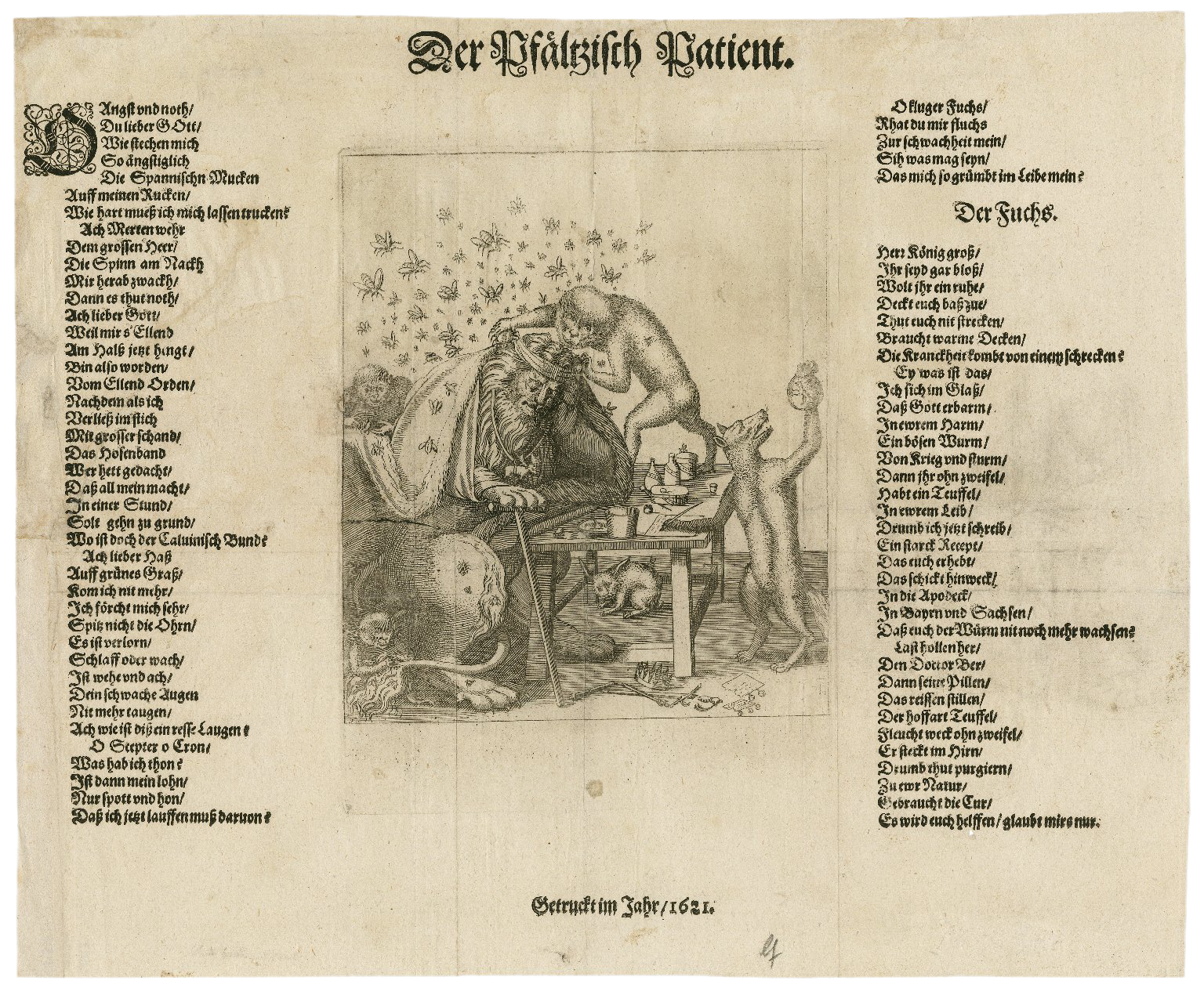
This image was made by an engraver and printed by a rolling press printer using special techniques and materials that cannot be found in a letterpress print shop. Usually, letterpress text is printed first and the printed sheets with blank spaces for images will be delivered to the rolling press printer for production. Yet another craftsman would be needed for binding.
Etchings like this one were printed from flat copper plates, the faint outline of which is visible here. These outlines are called “plate marks” and can help readers today understand and identify the materials used to create a printed image.
Anonymous print production is a common occurrence, especially when content is political, as it is in this broadside. (See the Folger catalog entry to learn more about the political content.) Neither the lettterpress printer who printed the text, nor the artist who designed the image, nor the draftsman who etched it, nor the rolling press printer who printed the etching on this print are known.
Text and image: How were they printed together?
Membership
Photograph of Dorothy Porter Wesley instructing manuscript staff: Thomas Battle, Evelyn Brooks-Barnett and Denise Glelin, Howard University
Nourish your bibliographical practice by joining the BSA. Our members form a community of scholars, students, collectors, curators, booksellers, and librarians who uplift bibliographical teaching, learning, and scholarship across disciplines. Specially curated member-only benefits support your bibliographical practice. Join today!
Consider making a contribution to our Annual Fund to help secure a vibrant future for the study of the material text.
